 | |
|  |
|
|
view titles only (low bandwidth) |
| |
| Moon gravity mapping with GRAIL | Aug 31, 2011 1:04 AM PDT | url |
| | |
Added 1 new A* page:According to this NASA article, the GRAIL spacecraft are scheduled for launch next Thursday, September 8th. Here they are--the two copper-foil-covered-looking boxy things--sitting on their booster as the payload fairing is put in place:
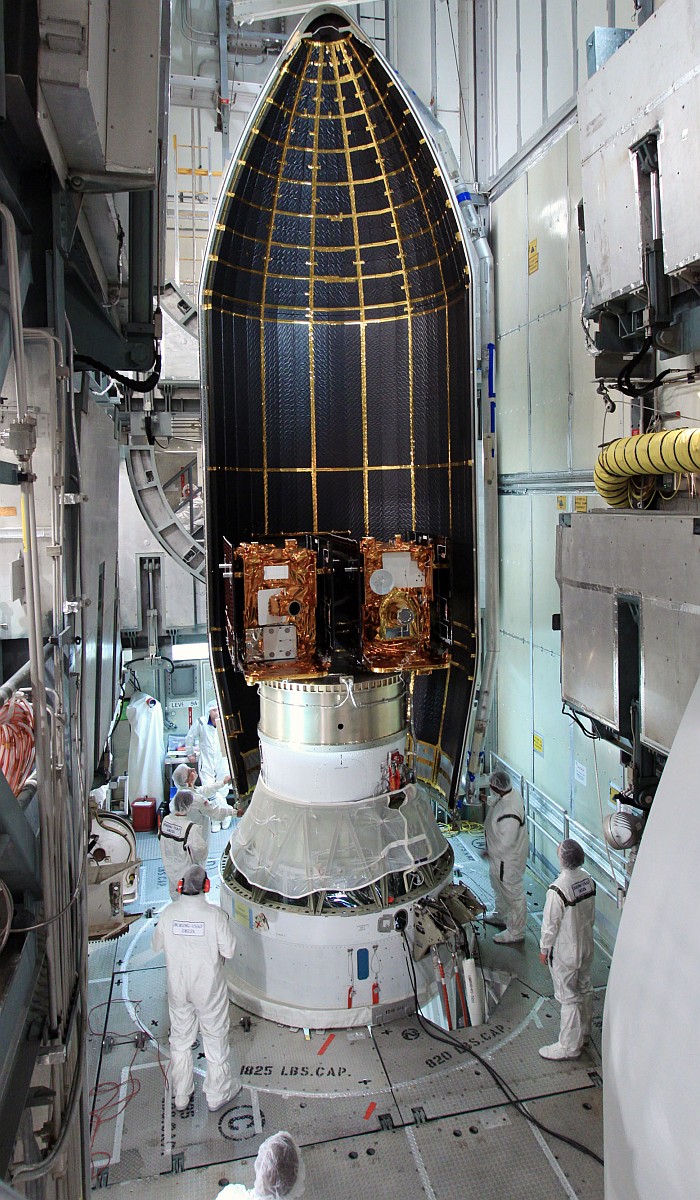
image by NASA (source)
"GRAIL" stands for "Gravity Recovery And Interior Laboratory," and it's a pretty interesting mission: two probes will drop into a very low 50 km orbit over the Moon, about 200 km apart. Getting into such a low orbit is a tight piece of flight engineering: their launch window lasts just one second, and only comes along twice a day. Once in lunar orbit, they'll send each other radio signals to measure their exact distance from each other, which is expected to vary ever so slightly due to "regional gravitational differences" as they fly around the Moon. Measuring those differences, then, should yield a detailed map of the Moon's gravitational field and that, in turn, will reveal the underlying density of the lunar landscape, which should tell scientists a lot about its composition.
This isn't the first time NASA has tried to pry deep into the Moon's interior: to quote myself from this old A* news article: "Back in '71, they smashed Apollo 14's rocket booster into the surface, leaving an impressive 115'-wide crater and generating 'moon quake' readings read by seismographs that had been placed on the Moon by the Apollo 12 crew two years earlier." But as the mission's lead investigator, Maria Zuber of MIT, noted in this 2008 podcast interview, "We’re actually going to produce a gravity map of the moon that’s going to have a spatial resolution better than the global gravity model for Earth," and that's because, due to the Moon's lower gravity, the mapping satellites can orbit a lot closer to the surface there than they can around the Earth. She also mentions that we don't even have a good idea how thick the Moon's crust is--GRAIL should give us that answer.
~~~~~~~~
Noticed a couple other sorta interesting random articles today:
- This one is about a certain western Australian dolphin population, which has already been observed developing several foraging techniques (one involving breaking off a conical piece of sea sponge and wearing it on their head like a hat to shield themselves as they forage on the sea floor) and spreading them "vertically" through the female population, from mother to daughter. Now they've got a new trick--picking up conch shells in their mouths and shaking them to dislodge and swallow the fish sheltering inside--that seems to be spreading "horizontally"--from friend to friend, as it were. Just a reminder that humans didn't invent social networking. :P
- This one is actually not so much an article as it is a little slideshow of a Chinese farmer's self-made miniature submarine.
|
·····
|
| |
| Wiley Post and the pressure suit | Aug 30, 2011 1:52 AM PDT | url |
| | |
Added 1 new A* page:In the excitement of movie night on Friday, I neglected to ask you to take a look at my weekly fairy tale comic, "The Princess and the Giant," so I'm taking the opportunity now to tease/link you to the previous week's page of that comic:

And this week's page is there after that one, but I'll wait until Friday to bug you about that one. :D
Also, thanks to Shards, Ears for Elves, and SporkWeb for linking to the Princess. Yay! :)
~~~~~~~~~~
There are apparently questions now as to whether the International Space Station might have to be evacuated in the coming months, since their last supply ship, a Russian unmanned Progress module, crashed at launch last week. I bring that up only because in NASA's article about the crash that I linked last week, there was a little mention of pressure suit preparation that I found interesting; talking about two cosmonauts getting ready for their departure that had been scheduled for September 7th (the crash kind of threw various other ship schedules up in the air), the article said "Borisenko and Samokutyaev also donned lower body negative pressure suits that draw body fluids towards the feet. This is standard protocol for cosmonauts preparing to return to Earth after long duration missions in space."
Negative pressure suits! Whoa. That got me thinking about pressure suits in general, and led me to aviation innovator and intrepid pilot Wiley Post. Born in Texas in 1898, Post was a circus parachutist and barnstormer in his 20's, and even losing his left eye in an oil field accident at age 27 didn't slow him down--in fact, he used the settlement money to buy his first airplane.
He became a successful air racer--winning the 1930 National Air Race Derby from LA to Chicago in 9 hrs. 8 min. 2 sec., for instance--but he had his sights set on even bigger things. At the time, the round-the-world air record, of 21 days, was held not by an airplane, but by an airship: the Graf Zeppelin, a 237 meter-long (776 feet) German airship capable of carrying 20 passengers beneath its massive hydrogen-filled balloon, which it could propel through the air at up to 128 km/h (80 mph). The Graf was the largest airship in the world when it was completed in 1928 (here it is still looking pretty big in 1930):

image by Grombo (source)
The Graf made its round-the-world flight in 1929, a voyage sponsored by American newspaper tycoon William Randolph Hearst, who shelled out $200,000 for exclusive media rights to the voyage.
Apparently, an airship holding the round-the-world record didn't sit well with airplane pilots of the time of the time. Post and his navigator, Harold Gatty, took up the challenge, and in 1931 set off from Long Island to break the record in the airplane "Winnie Mae" (now at the Smithsonian's Steven F. Udvar-Hazy Center annex at Washington Dulles International Airport, along with such craft as the Enola Gay, the Space Shuttle Enterprise, the Gemini VII capsule, an SR-71 Blackbird, a Concorde, and many more; the Winnie Mae was owned by Oklahoma oilman F.C. Hall--Post was his personal pilot, and had already won the aforementioned National Air Race Derby in the Winnie Mae). Here are Post (on the left) and Gatty in front of the Winnie Mae at a stop in Germany during their circumnavigation attempt:

image by Deutsches Bundesarchiv (German Federal Archive), Bild 102-11928
The two made it back to Long Island, having gone around the world in just eight days, shattering the Graf's record. They were the toast of the nation, getting a lunch at the White House and a ticker-tape parade in New York City; their account of the journey sported the clever title of "Around the World in Eight Days." (Take *that*, Jules Verne! :P)
Far from resting on his laurels, with the latest air technology, the Sperry autopilot system (capable of performing even automatic takeoffs and landings) and radio direction finder, Post set out to complete a solo round-the-world flight in 1933, which he completed--the autopilot having required three repairs en-route--in just seven days, breaking his previous record and earning himself another ticker-tape parade in New York.
The next year, Post set out to break the altitude record. Because the Winnie Mae's cockpit could not be pressurized, he worked with Russell S. Colley of B.F. Goodrich to develop what would be the world's first "practical" pressure suit. Made of long underwear, rubber, and rubberized parachute fabric glued to an articulated frame, with an aluminum and plastic diver's helmet that could carry earphones and a throat microphone, the suit, with the eyepatch-wearing Post inside, was a formidable creation:

image by NASA (source)
(This page has a neat photo of him sealed in the suit, looking like something out of Forbidden Planet.)
His first flight in the suit reached 40,000 feet over Chicago, and he eventually got up to 50,000 feet.
Still determined to push his airplane's limits, the following year--1935--he attempted four high-altitude transcontinental flights from LA to New York; all four attempts ran into mechanical problems, but Post's observation that his ground speed significantly exceeded the airspeed shown by the Winnie Mae's instruments during these attempts has led some to credit him with the discovery of the jet stream.
That same year, with his close friend Will Rogers--they had met when Post flew Rogers to a rodeo in the late 20's--Post took up the task of "surveying a mail-and-passenger air route from the West Coast of the United States to Russia." Low on cash, he built himself an airplane using parts he salvaged from two different aircraft. Caught in bad weather after leaving Fairbanks, they landed in a lagoon to ask for directions--but in taking off from the lagoon, the airplane's engine failed, and both Post and Rogers were killed when it crashed back into the water. Post was 36 years old.
His pioneering pressure suit is now at the Smithsonian, I *think* at the same facility as the Winnie Mae. They have a good color photo of it posed for display here.
|
·····
|
| |
| Movie night: Heli drones, Milky Way, Phantom | Aug 27, 2011 2:33 AM PDT | url |
| | |
Added 1 new A* page:Movie night!
This shows a pretty neat quadruple helicopter remote spy drone thingy used by the Libyan rebels; they're manufactured by a Canadian company, and go for a mere $100-200,000 a pop, according to this article:
https://www.youtube.com/watch?v=DQ3hEt0EOkc
Here's a really pretty time-lapse video of the Milky Way spinning over the night skies of South Dakota—A*'s right in the middle there, you know!—this summer:
http://vimeo.com/28040685
If you like that one, you'll probably also like the one I embedded in April.
And to complete our triple feature, we have the 1929 silent film version of "The Phantom of the Opera," starring Lon Chaney in the title role:
[Edit 5/26/18: video no longer on YouTube]
I've never seen any of Chaney's other movies, and I'm hoping it's just a really good make-up job in this, because otherwise...he's a *really* creepy looking dude. The exaggerated expressions and variable film speed of silent movies seem a bit corny these days, but when well done—as I think they are here—they're also...kinda mesmerizing. I also find this particular film interesting because of the use of different color tints over the film, to give different effects to different scenes (something I've done once in A*! maybe I'll have to do that some more).
Hm, the Wikipedia page on the movie is an interesting read! Says Chaney was given the freedom to do his own makeup; and there's the story that some members of initial audiences fainted when his visage was first unveiled.
And there were many versions of the movie! Universal actually put out not one but three versions in 1925: audiences didn't like the first, so the director was fired, and the thing was re-shot; they didn't like the second, either, finding it too long, so that was pulled and a tightened up version was released, and third time was the charm.
But that wasn't the end of it! Sound movies were just coming along, and so about half the movie was re-shot to add spoken dialogue for a sound version released in 1930—that version, however, has not survived. Chaney's voice was not included in it, as he was with MGM by that time; posters for the film version had to emphasize "Lon Chaney's portrayal is a silent one!" The best surviving print is supposed to be one "struck from an original camera negative for George Eastman House in the early 1950s by Universal Pictures," but it seems to be a combination of the 1925 version, and some of the silent parts from the 1930 version, which mostly used footage taken by a second camera, so the action is seen from slightly different angles.
Oh yeah! I also like the extensive use of creepy shadows—some of which are clearly painted on, but hey! It's also interesting to note that some scenes of the 1925 version were filmed in the fancy new Technicolor process; only one has survived: the riotous "Bal Masqué" party scene.
|
·····
|
| |
| Return of the Space Module (Zarya & Unity) | Aug 26, 2011 3:39 AM PDT | url |
| | |
Added 1 new A* page:Figure I might as well get through the last--or the first, rather--of the modules on the ISS, seeing as how I sorta mentioned them yesterday. The third module, the Zvezda, shown yesterday, attached to an earlier Russian module, the Zarya ("Dawn" in Russian), which was in turn attached to an American module, the Unity.
Zarya was the first module to launch, on November 20th, 1998, on a Proton rocket, Russia's most successful rocket line (still in use, too, but the Progress module that crashed during launch yesterday was on a Soyuz rocket--those are the ones with the easily spotted conical thrusters). Here's a nifty photo of Zarya launching in its Proton rocket from Baikonur Cosmodrome in Kazakhstan:
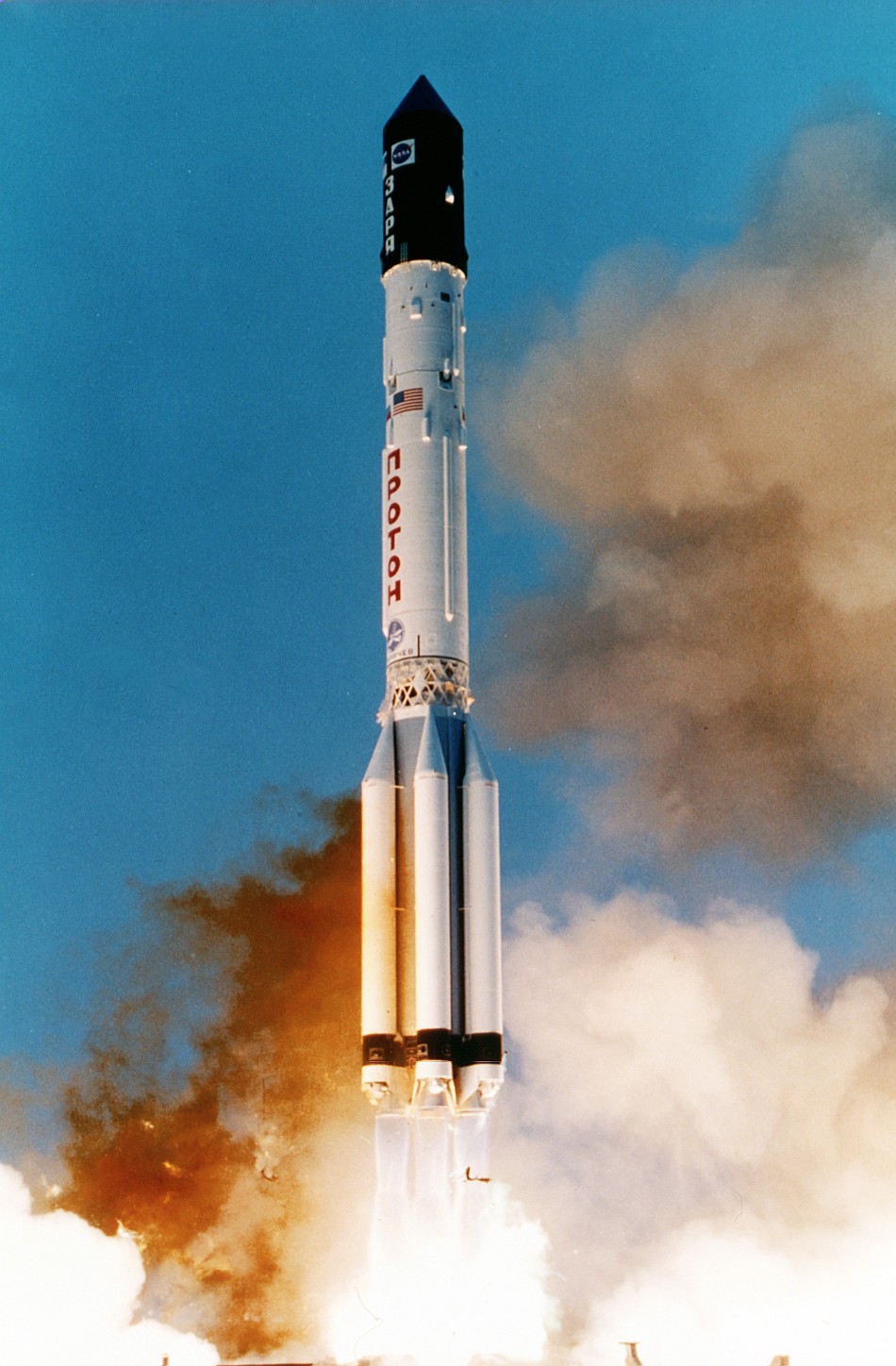
image by NASA (source)
The Unity launched in the cargo hold of the Space Shuttle Endeavour a couple weeks later--December 4th--and the two modules were brought together--the Zarya
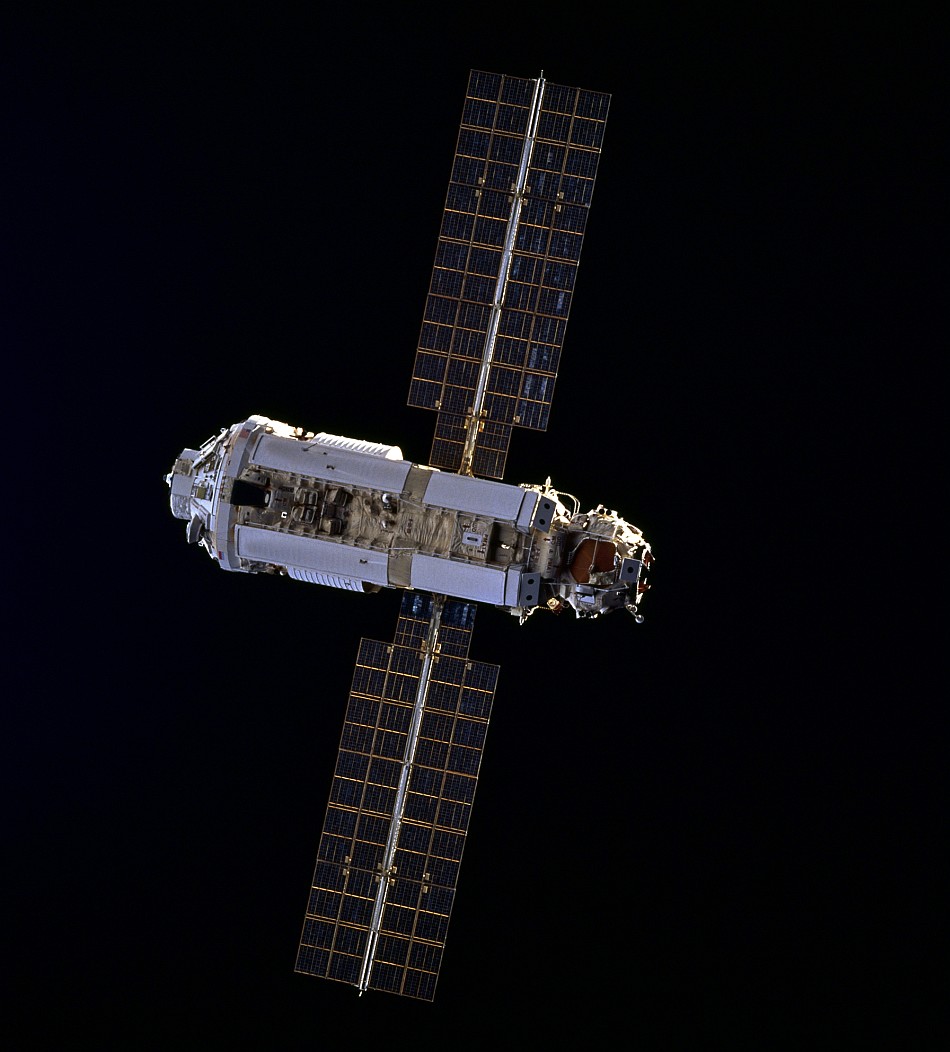
image by NASA (source)
met up with the Unity, and two days later, on December 6th, was born Zaryunity (okay I made that up), aka the International Space Station:
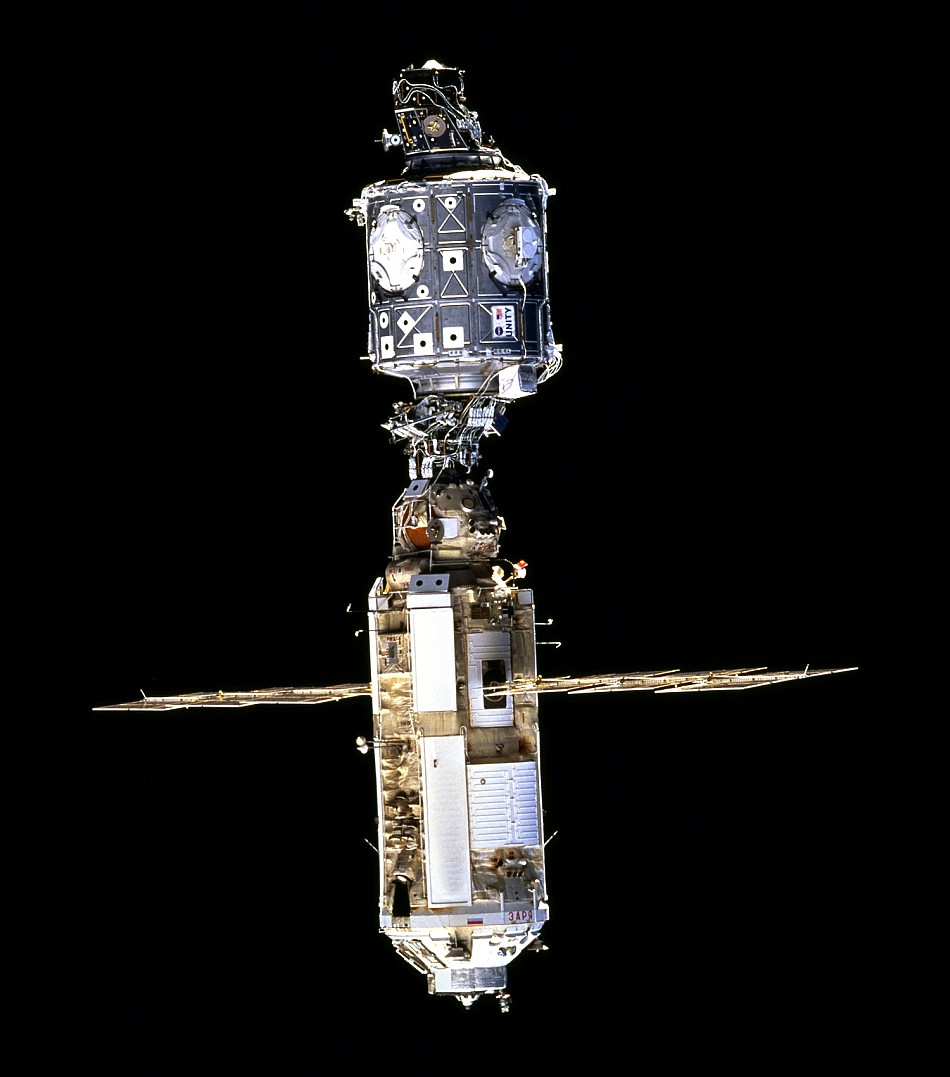
image by NASA (source)
The Unity, as its name suggests, is a connecting module, with lots of ports for other modules to plug into; the later Italian-built modules Harmony and Tranquility, which I talked about here and here, are also connecting modules, although they're based on a different, somewhat larger design (21 feet long vs Unity's 15 feet).
With its own thrusters, solar panels, batteries, and radiators, Zarya was "designed to fly autonomously for six to eight months," but ended up having to run on its own (the connecting module Unity, not being connected to anything else, being more or less dead weight) for almost two years due to delays in getting the next module, the Zvezda, ready--the Zvezda wasn't launched until July 12th, 2000, and was finally connected to the Zarya two weeks later, on July 26th, by a Space Shuttle crew. Now that Zarya is permanently attached to Zvezda, it can't use its main thrusters, so it stores fuel for the Zvezda, and in fact is mostly used for storage.
There are even more modules on the ISS, but, eh, well maybe I will talk about them some day, who knows--or you could just check out the list of them here. For now I'll settle for a nice photo of the station as it pretty much looks now, although this photo, from May 30th of this year, also includes the ATV Johannes Kepler, with its X-wing solar panel array, at the bottom (the Kepler was filled with trash and de-orbited to burn up in the atmosphere in June):
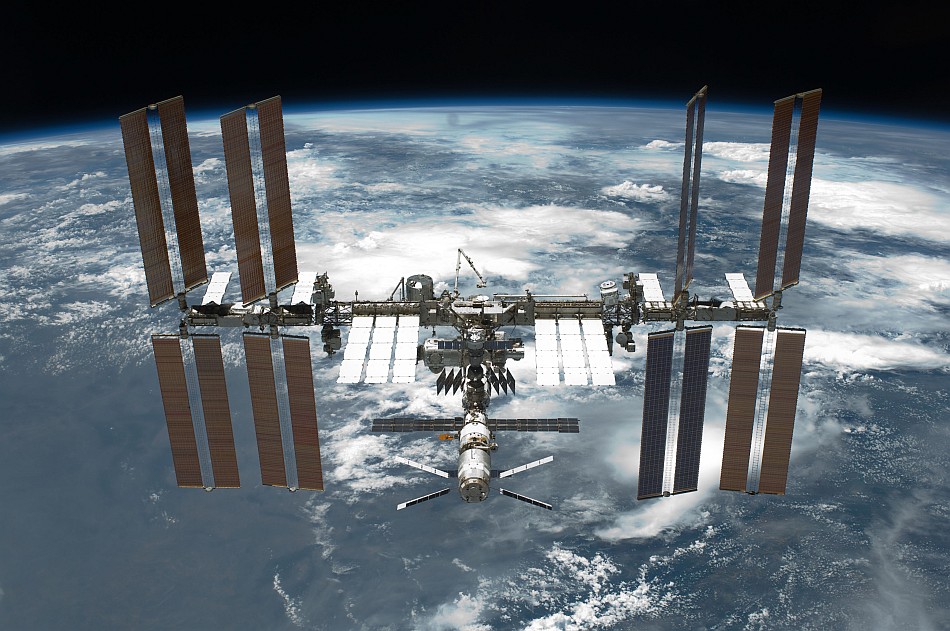
image by NASA (source)
Only one more major component is planned: the Russian science module Nauka ("Science" in Russian) is due to launch in May 2012, and it will replace the Russian docking compartment, Pirs ("Pier" in Russian), which hasn't been all that useful since the main module it was going to connect to was cancelled; once the Nauka shows up, the Pirs will be the first ISS module to be decommissioned--ie, disconnected and burned up in atmospheric re-entry; I suppose, to add insult to injury, they will probably fill it with trash first.
The life of a space module is a hard one!
|
·····
|
| |
| Space module revenge: Progress and Zvezda | Aug 24, 2011 11:58 PM PDT | url |
| | |
Added 1 new A* page:I just finished my space module round-up a couple days ago, and then today a different type of space module goes and makes the news: the Russian Progress M-12M, an unmanned supply ship for the International Space Station, much like the ATVs I was talking about a few days ago, crashed in Siberia--supposed shaking windows for 100 km around--after a failure in the third launch stage of its Soyuz rocket.
Progress craft have been used since 1978 to carry supplies to Russian space stations--and as far as I can tell from the chart in that last link, this was the first one--of well over 100 flights--to have a launch failure (others have conked into a space station or two accidentally), which is rather remarkable; currently three to four launch for the ISS every year. Here's what one looked like in 2005, preparing to burn up in the atmosphere with a full cargo of station waste:
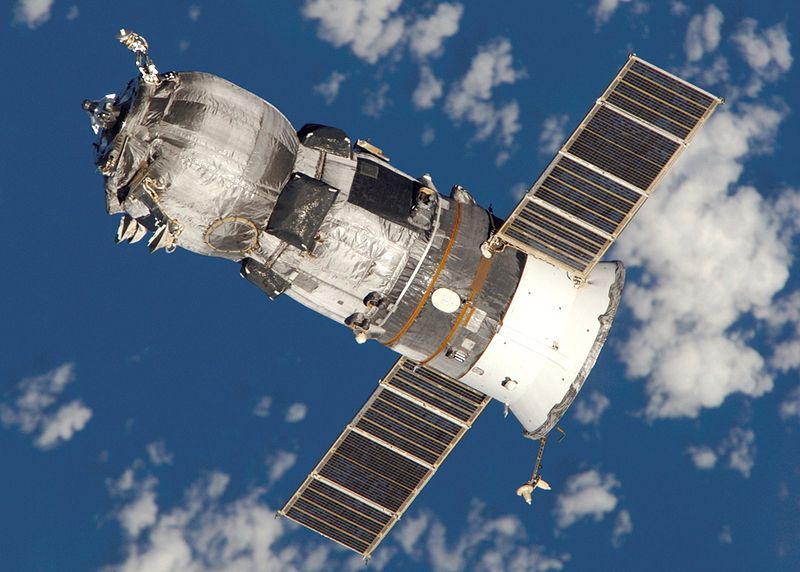
image by NASA (source)
And attached to the ISS (at the bottom of the image) in 2000:

image by NASA (source)
Notice how much tinier the ISS was in 2000! The module the Progress is docked with is Zvezda, a Russian-built module added in 2000--the third module of the station. (Interestingly, the rocket that launched the Zvezda was the first to carry advertising--a Pizza Hut logo, the company reportedly paying $1 million for that particular high-flying advertisement.) Its frame however had actually been completed way back in 1985--it was originally going to be the core module of Mir-2, a proposed successor to the Russian Mir space station.
Zvezda, which means "star" in Russian, has sleeping compartments for two cosmonauts, a NASA treadmill, an exercise bike, an uncomfortable-looking toilet
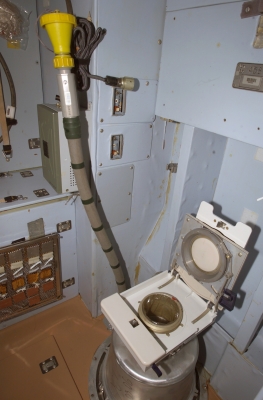
image by NASA (source)
a refrigerator, the primary Russian guidance and navigation computers, thrusters for maneuvering, batteries, and the "Elektron" system that converts humidity and waste water into hydrogen (expelled into space) and oxygen by electrolysis. Elektron has failed three times so far--not a great record--forcing the crew to use backup oxygen supplies; a US backup system arrived in 2007, but Elektron hasn't had a major failure since then.
Here's a handy diagram of the Zvezda:
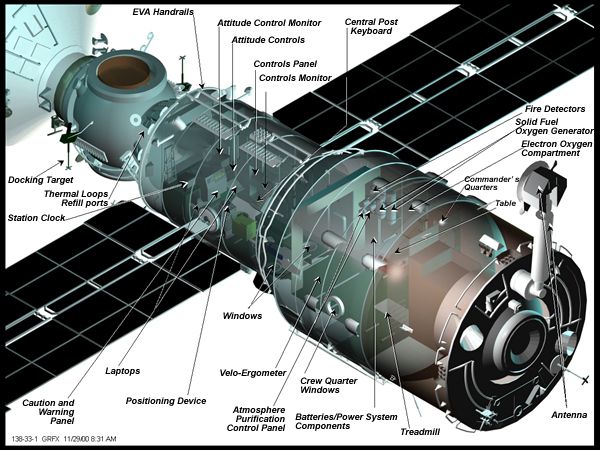
image by NASA (source)
~~~~~~~~
Also today I noticed an interesting AP article saying a recent University of Hawaii study has calculated there are about 8.8 million species of life on Earth; we know of 1.9 million, so supposedly we have a long way to go in finding the rest, the problem being that they're tiny and/or in difficult-to-reach environments, like ocean floor vents, or deep underground areas. But other estimates have placed the species total between 3 and 100 million, so who knows.
And here's a short slideshow that went with the article, showing some funky tiny species discovered in recent years, including the world's tiniest snake species, which can curl up comfortably on an American quarter dollar coin.
Oh! And the article also mentioned the Encyclopedia of Life, a Wiki-like project with the goal of having a page for every species. The layout seems cluttered and confusing, and I'd think it'll mostly be duplicating content on Wikipedia anyway, but nonetheless, an interesting endeavor.
|
·····
|
| |
| TRACE and coronal loops | Aug 24, 2011 12:49 AM PDT | url |
| | |
Added 1 new A* page:I came across an interesting "modern noir crime graphic novel" being published for now in webcomic format, caled Running With a Gun. Very neat black and white art.
~~~~~~~~
Well it was a while back now (I keep coming across other things I want to talk about while looking things up, so now I have a considerable stuff-to-talk-about backlog!) that I was talking about active regions on the Sun--sunspots, for instance. A much cooler-looking active region type, though, are coronal loops: magnetic field lines that emerge and loop back into the Sun, and which are filled with solar plasma caught in the magnetic tube of the field line. Some nifty examples of coronal loops:

image by NASA (source)

image by NASA (source)
Those images were captured by NASA's TRACE satellite ("Transition Region and Coronal Explorer" -- active 1998-2010), whose primary mission was studying coronal loops. To really get a feel for the amazing quality of TRACE's cameras, though, you've got to check out the videos it captured of many loops and solar flares; there are a lot of them, and they are available for download here, mostly in .mov format. I suggest sampling through a bunch of them, but if you just want to check out a few, 57, 84, 85, 103 and 104 are some of my favorites. Oh, and in 96, you can see a coronal mass ejection, where a big part of the surface wells up like a bubble which then bursts, flinging solar material into space.
Here's a mosaic of TRACE images, put together to show the whole Sun; the red, green and blue are false color, from passes at three different wavelengths:

image by NASA (source)
It's worth mentioning though that it was actually the Japanese Yohkoh satellite (that's "Sunbeam" in Japanese) that really kicked off the study of coronal loops. It was active from 1991 to 2001.
|
·····
|
| |
| Robot space modules: good or evil? | Aug 22, 2011 11:53 PM PDT | url |
| | |
Added 1 new A* page:There is a very nice new review of A* on Champion City Comics. Thanks guys!
~~~~~~~~~~
I talked about the Destiny module of the International Space Station a bit last week; well, as luck would have it, today the possibly evil Robonaut 2 was just unpacked and switched on in that very module! It could even now be looking down at us through the module's 20" portal window. :o
And to finish up my space module round-up, let's start with the ESA's unmanned Automated Transfer Vehicles ("ATVs"). Their cylindrical design also goes back to the Spacelab modules; these German and Italian-built disposable modules are intended to go up to the ISS every year or so with vital supplies. They launch on the ESA's Ariane 5 rockets from the French Guiana Space Center in French Guiana, South America, possibly looking something like this from the ground (this photo is of an otherwise unrelated Ariane 5 satellite launch there in 2010):
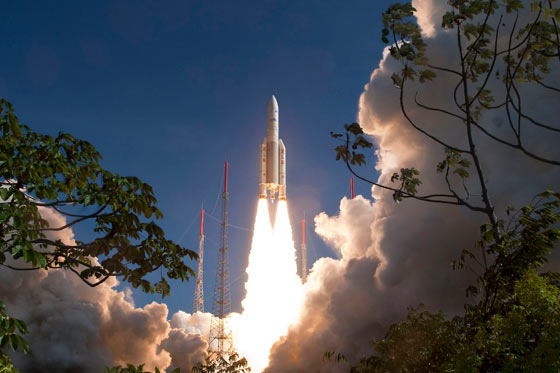
image by Douglasfugazi (source)
and like this from the ISS (that's the Johannes Kepler launching in the far distance, as seen from the station):
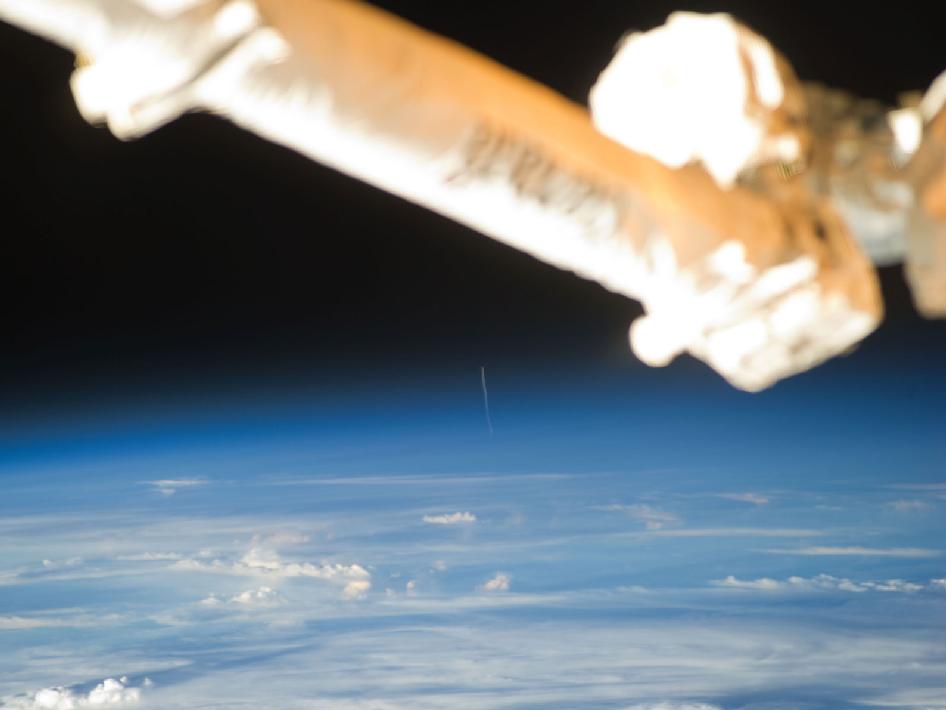
image by NASA/ESA (source)
So far there have been two ATV missions to the ISS: the Jules Verne in March 2008, and the Johannes Kepler in February 2011. They fly up, attach to the station, and their cargo is unloaded. Here are some shots of the Jules Verne approaching the station:
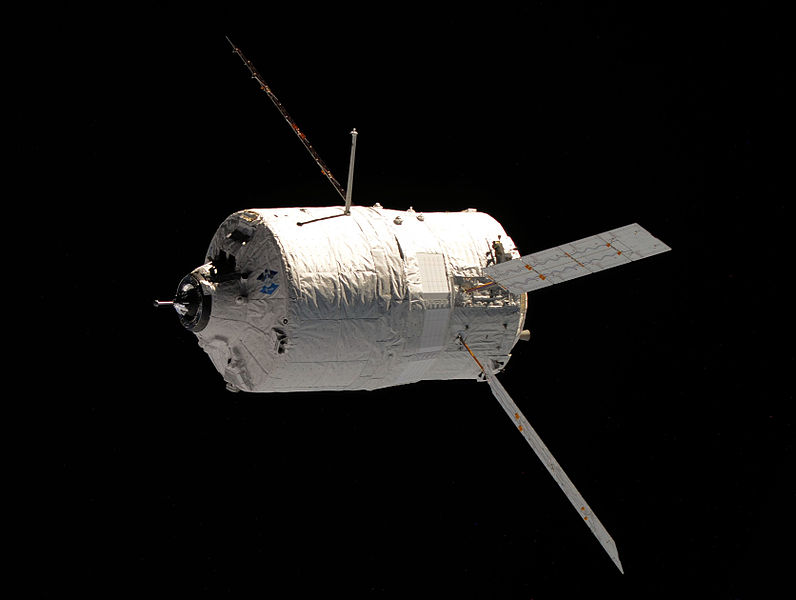
image by NASA (source)
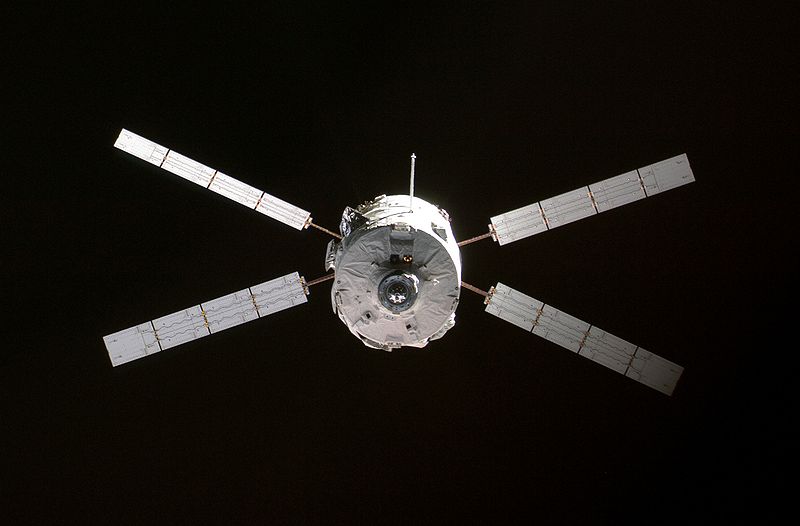
image by NASA (source)
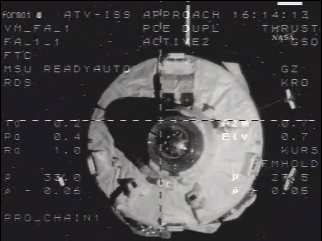
image by NASA (source)
They remain attached for four to six months, looking almost like any other station module aside from their X-wing solar panels, and are steadily filled up with the station's waste products. While attached, they can use their thruster to boost the station's orbit. Here's the Johannes Kepler attached (at top, with the X-shaped array of solar panels):
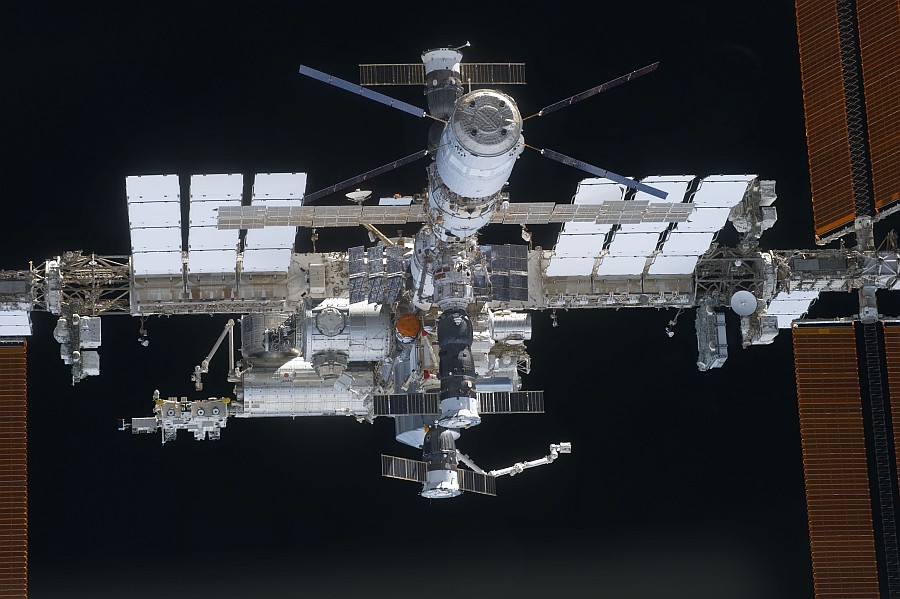
image by NASA (source)
and the Jules Verne (at bottom):
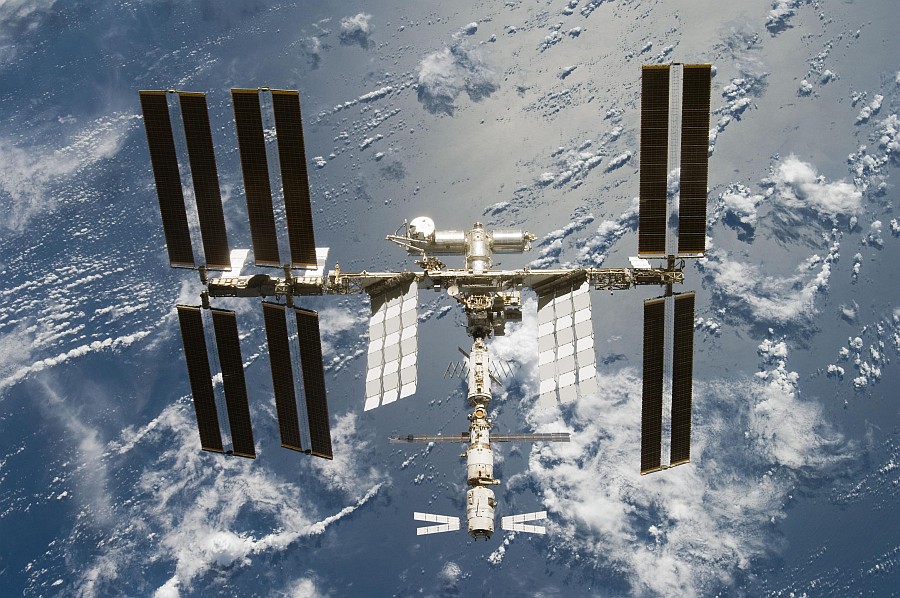
image by NASA (source)
Once they're full of garbage, they detach and fall back into the atmosphere, where they very neatly burn up, like the Jules Verne did in September 2008 just southwest of Tahiti:

image by NASA (source)
Three more ATV missions are planned: the Edoardo Amaldi (named after the Italian physicist) in February 2012, the Albert Einstein in February 2013, and an as-yet-unnamed fifth ATV in February 2014.
And finally, there is the privately-developed American and French Cygnus spacecraft. Funded by NASA, they are unmanned resupply craft like the ATVs, intended to do much the same thing, and once again utilizing the old Spacelab-derived cylindrical design for their cargo modules. The Cygnus' first "demonstration flight" was originally supposed to have taken place last year, but it has been pushed back to December of this year.
And that's everything I know about space modules!
|
·····
|
| |
| Tranquility, space pin-ups, & C.O.L.B.E.R.T. | Aug 20, 2011 2:25 AM PDT | url |
| | |
Added 1 new A* page:A super-big "you are awesome" to the guys at BurntWeiners.com ("A Comic Book Review & Discussion Podcast From Guys Who Know Less About Comics Than You Do!") for not only writing up a really nice review of A*, but also for spending about eight minutes of (note: contains lots of (im)mature language in amusing banter form!) their most recent podcast discussing it. :) I always love to see (or hear!) what other people think of A*, and this is, like, the most people have had to say about it in one go before, and certainly some of the most well-articulated things that have been said about it, so that was really nice to get to listen to.
But also check out that podcast if you just have any interest in other webcomics whatsoever, because they really did come up with a large number of very interesting ones. And if you enjoy that, their earlier webcomics podcast, from last October, is a good listen as well.
~~~~~~~~~
All right, time to continue the space module coverage I started yesterday!
I already talked about the Italian-made Harmony and Columbia modules of the International Space Station, so today I'll start off with the most recent one: Tranquility, made by the ESA (European Space Agency) and ISA (Italian Space Agency), was lifted up to the station in February of last year by the Space Shuttle Endeavour; Wikipedia has this really fantastic photo of the module being transferred from Endeavour to its spot on the ISS:
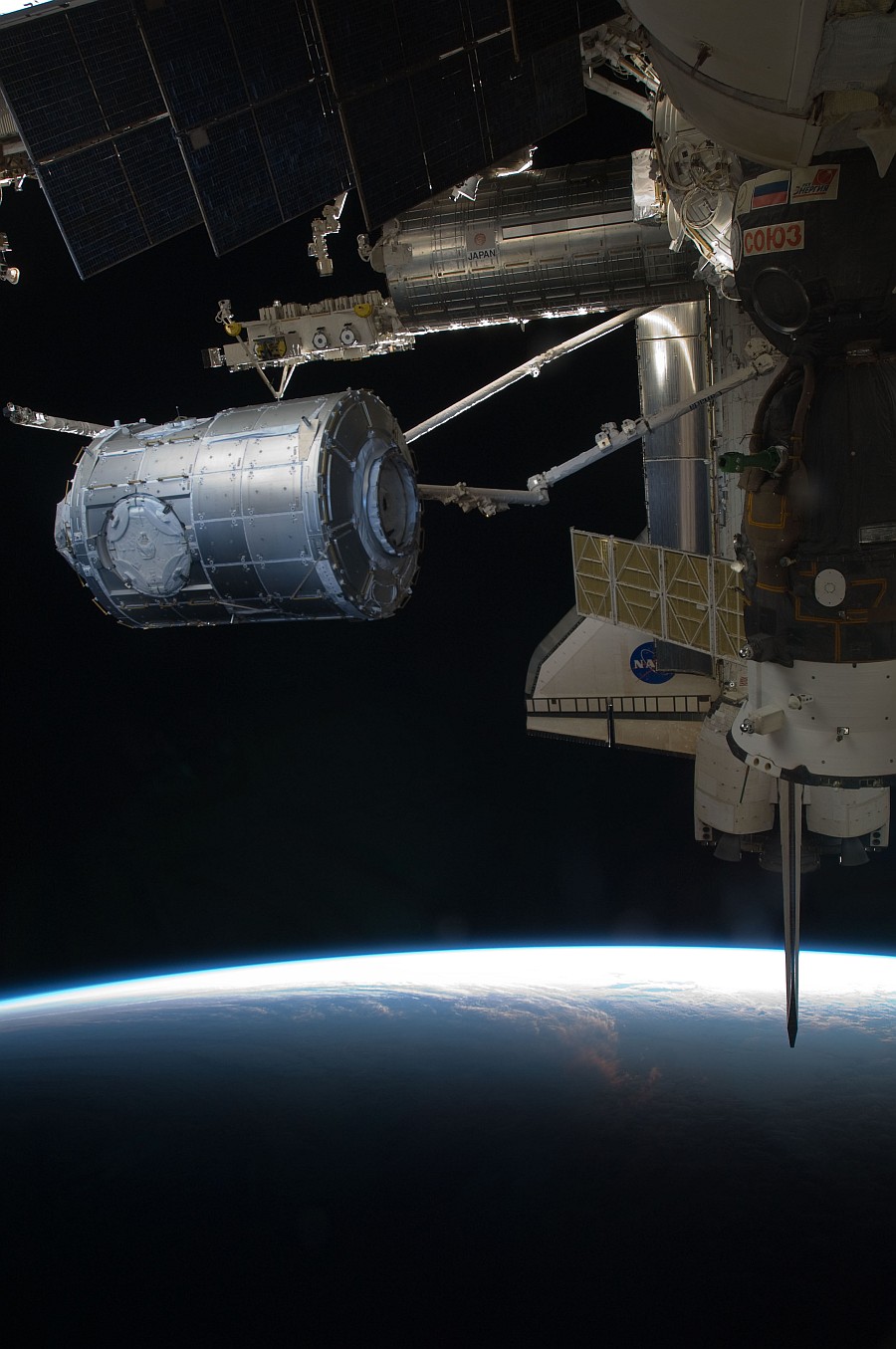
image by NASA (source)
Tranquility has "the most advanced life support systems ever flown in space," recycling waste water, generating oxygen, and monitoring and cleaning the air in the station. It hosts a bathroom, and is also used for "exercise, storage, and robotics work in connection with Cupola."
I talked about the 20-inch window in the Destiny module yesterday, but Tranquility's Cupola is the largest window ever flown in space: about two meters in diameter, consisting of seven panes, each with a shutter that can be closed to protect the pane from micrometeorites and space debris. It also just looks really cool, so now I'm going to roll in a bunch of photos of it:
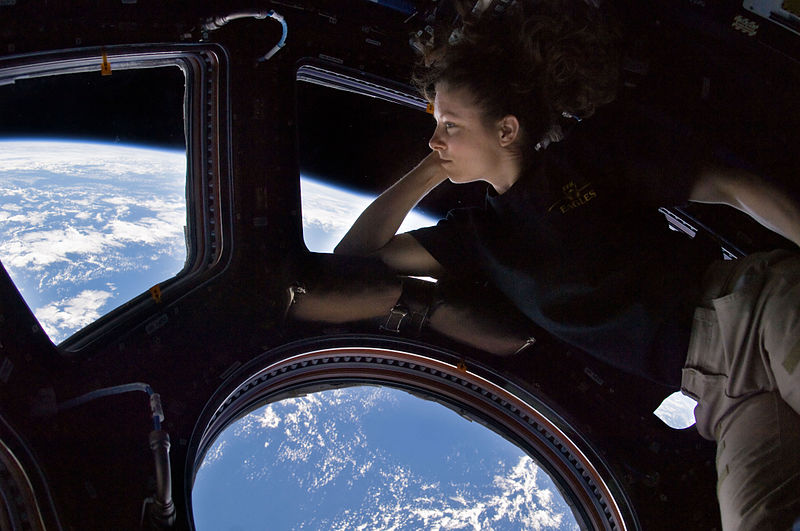
image by NASA/Tracy Caldwell Dyson (source)
^ A self-portrait! She did a pretty good job setting this one up, I'd say--not only getting the rim of the Earth just right, but also keeping her considerable hair out of the way!
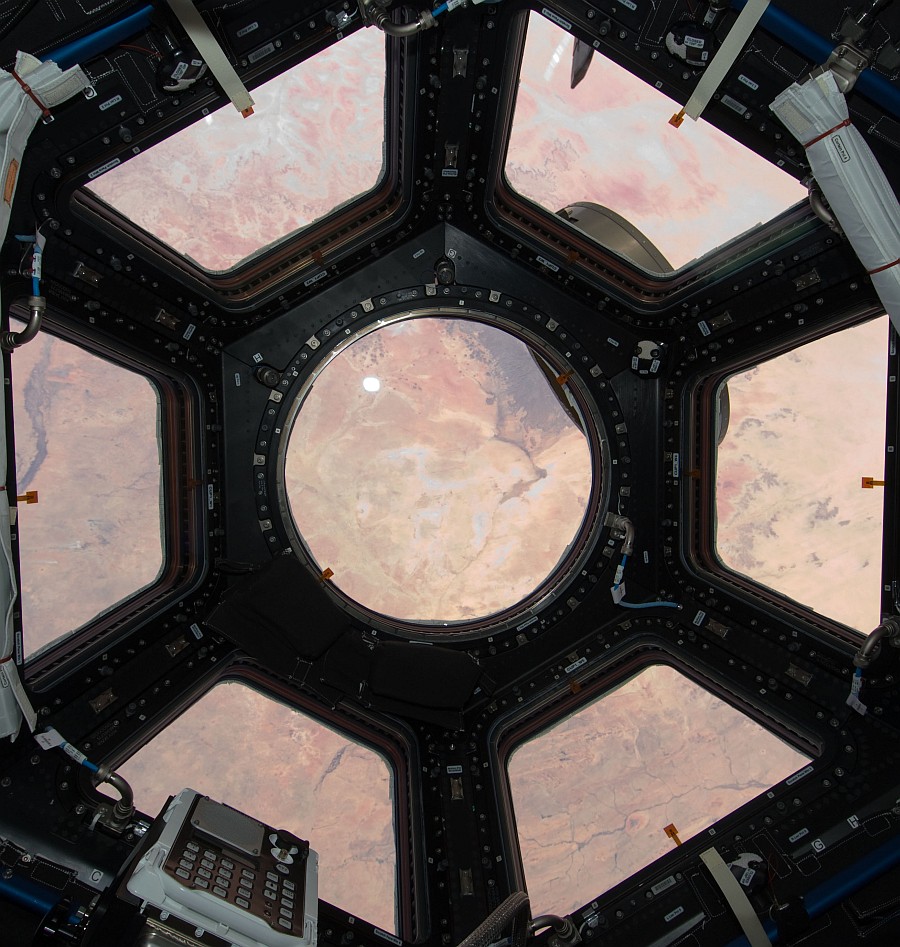
image by NASA (source)
^ The Sahara Desert seen through all seven windows.
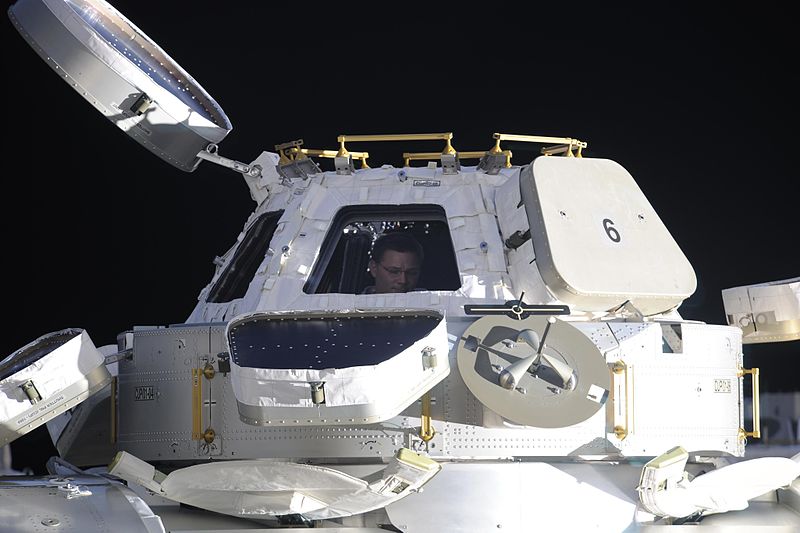
image by NASA (source)
^ Doug Wheelock working inside the cupola; here you can see the various positions of the protective shutters.
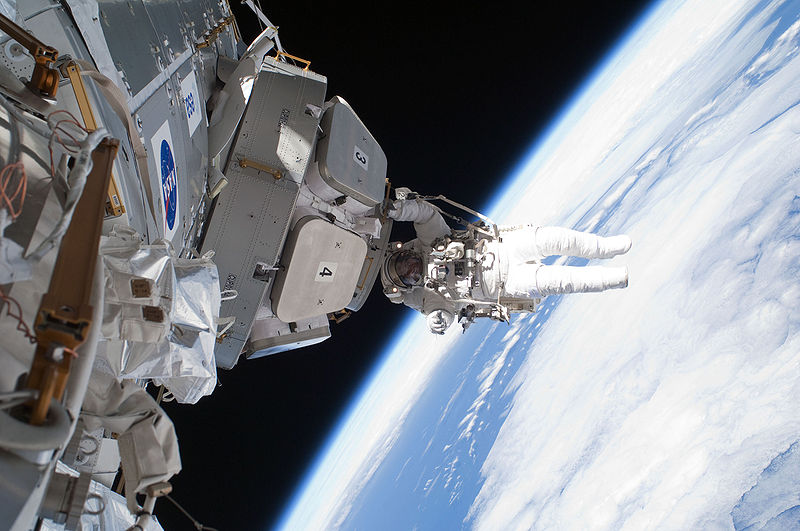
image by NASA (source)
^ Nicholas Patrick, removing the last of the insulation and launch restraint bolts from the newly installed Cupola in February 2010.
Tranquility gained a good deal of notoriety in the year before its launch, when popular television comedian Steven Colbert had viewers of his "The Colbert Report" show stuff the ballot box of the naming contest NASA was holding for the module. "Colbert" won, with nearly 20% of the 1.2 million votes--40,000 votes ahead of the runner-up, the NASA-provided name "Serenity." In the end, though, NASA I guess decided they'd better overrule that outcome, and decided on "Tranquility" in honor of the 40th anniversary of the Apollo 11 landing in the Moon's "Sea of Tranquility." But to show they were (sort of) good sports, they named the module's exercise treadmill "Combined Operational Load Bearing External Resistance Treadmill," or "C.O.L.B.E.R.T." for short. One of their best acronyms so far, you'd have to say!
There are still a few more descendents of Spacelab's modules to talk about, but there just too many cool photos to make people download in one post--so I'll have another big batch for you on Monday!
Oh and also don't forget to check for a new page of my weekly fairy tale comic, "The Princess and the Giant," this Sunday! Here's a teaser of and link to last week's page, in case you missed it:

|
·····
|
| |
| Space module madness! | Aug 19, 2011 4:24 AM PDT | url |
| | |
Added 1 new A* page:Thanks to AnsuGisalas for mentioning A* and my recent article with videos of some interesting DARPA projects (hypersonic planes, robotic hummingbirds and dogs, etc) on this TechRepublic article about DARPA's recent somewhat unsuccessful test of their Mach 20 Falcon HTV-2 aircraft. AnsuGisalas kindly referred to me there as an "advanced technophile"--I think "bumbling" would be much more accurate, but the link and the kind words are appreciated nonetheless. :)
~~~~~~~~~~
A little over a week ago I was talking about Spacelab, the modular, largely European-made space science experiment platform carried in the cargo bay on Space Shuttle missions. Well, the know-how obtained from that successful program paved the way for many other space modules--so many, in fact, that it's going to take me at least a couple days to tell you about them!
First, let's talk about the Multi-Purpose Logistics Modules, or MPLMs. They were originally to be built by Boeing, for a never-realized American space station--this was in the late '80s and early '90s--but the Italian Space Agency (ISA) eventually got the job, constructing these cylindrical modules, 21 feet long and 15 feet in diameter, capable of carrying nine metric tonnes of cargo to the International Space Station. Three MPLMs were built: the Leonardo, the Raffaello, and the Donatello.
Here's the Leonardo in the Space Shuttle Discovery's cargo bay in 2001:
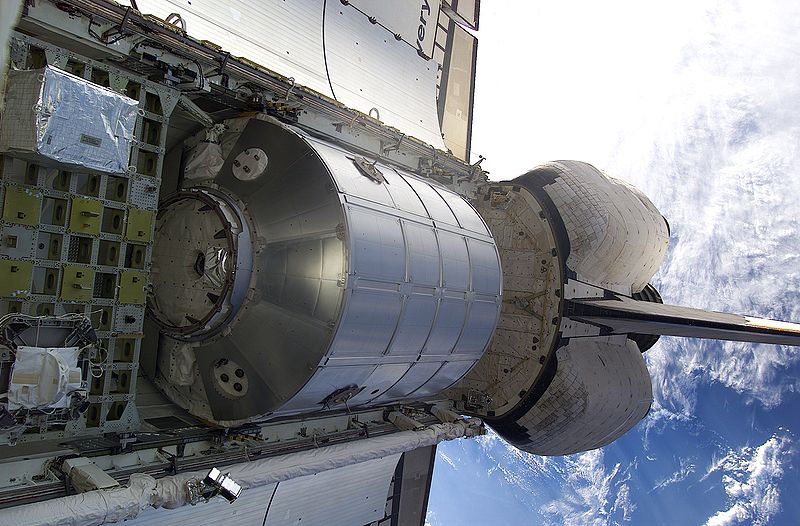
image by NASA (source)
And the Raffaello docked to the ISS in 2005:
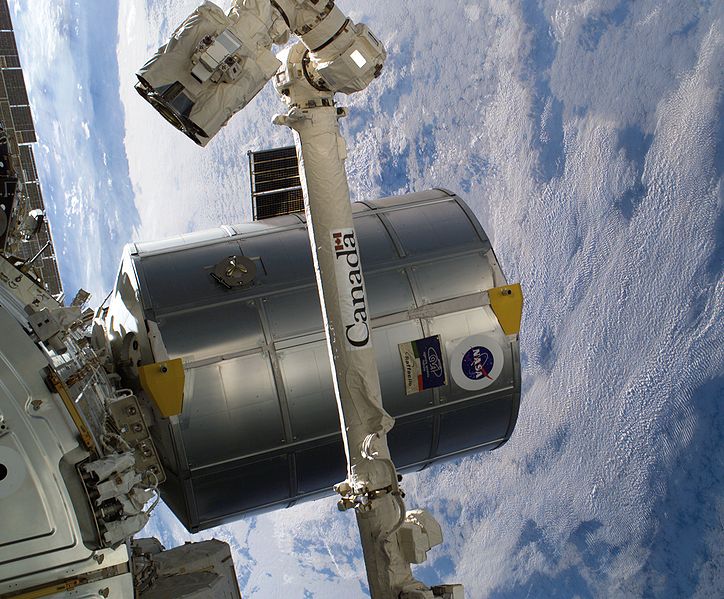
image by NASA (source)
And a view inside the Leonardo in 2001, with cosmonaut Yuri P. Gidzenko among the cargo, providing a handy scale reference:
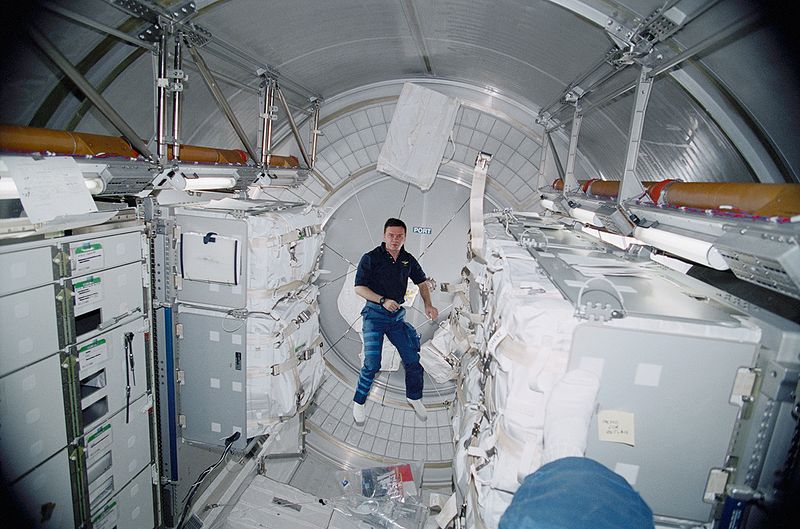
image by NASA (source)
The Donatello never flew, but its multi-layer insulation (in which multiple insulated thermal layers help lower heat loss from a spacecraft by reflecting half of the incoming heat back to the previous layer; the more layers you have, the less heat makes its way to the final layer and (half) out into space: "a typical insulation blanket has 40 or more layers") was stripped off, reinforced with Kevlar for micrometeorite protection, and installed on Leonardo when it was converted into the Permanent Multipurpose Module in February of this year--it is now a fixed part of the ISS.
And yes, those are the names ("Raphael" was spelled slightly differently) of three of the four Teenage Mutant Ninja Turtles. And in fact the official MPLM logo features a space-suited Ninja Turtle, in a rather unique cooperation with Mirage Studios, who owns the Turtles IP; you can see that logo here.
~~~~~~~~
Also made in Italy, this time by the ESA, were the Harmony, Columbus, and Tranquility modules of the ISS. They follow the same basic design principles established for Spacelab and the MPLMs, and were carried into space in Space Shuttle cargo bays. Here's Harmony, which provides data, power, and a connection hub for the station, being attached to the ISS in 2007:
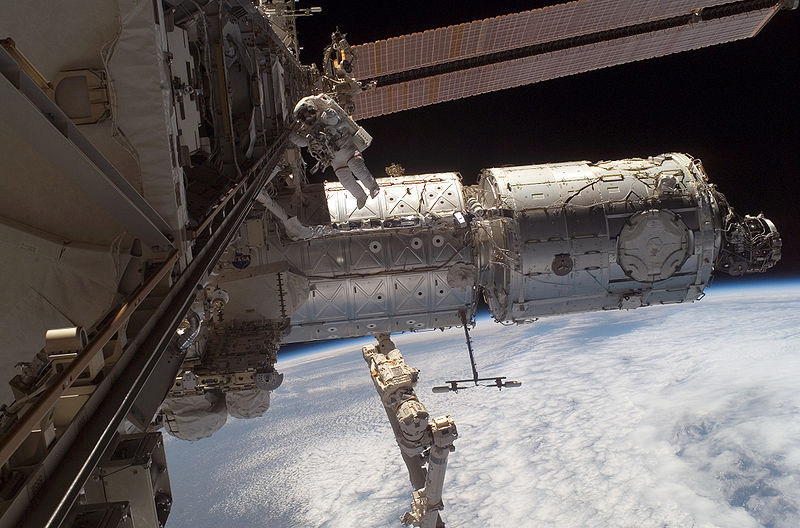
image by NASA (source)
It's attached to the Boeing-built Destiny lab module, incidentally; Destiny, also of a similar diameter, as it was carried up in the Space Shuttle Atlantis' cargo bay in 2001, has a nifty telescope-quality 20-inch glass window--it's the window often used by astronauts to capture high-quality views of the Earth below. A manually operated shutter protects it when not in use; here it is open for viewing in 2001:
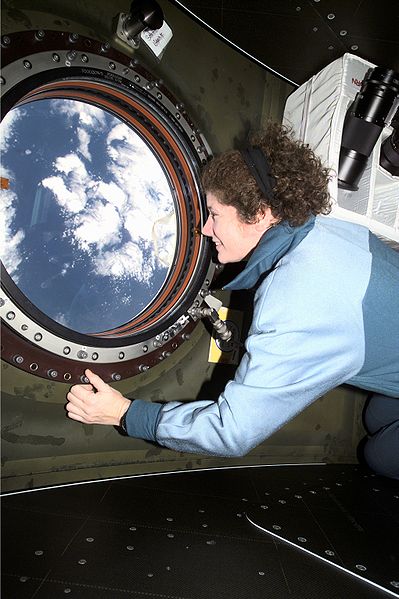
image by NASA (source)
(You can see the labelled shutter lever above the window there.)
But back to the Italian-built modules! After Harmony in 2007, Columbus was added the next year, attaching to the side of Harmony, like so:
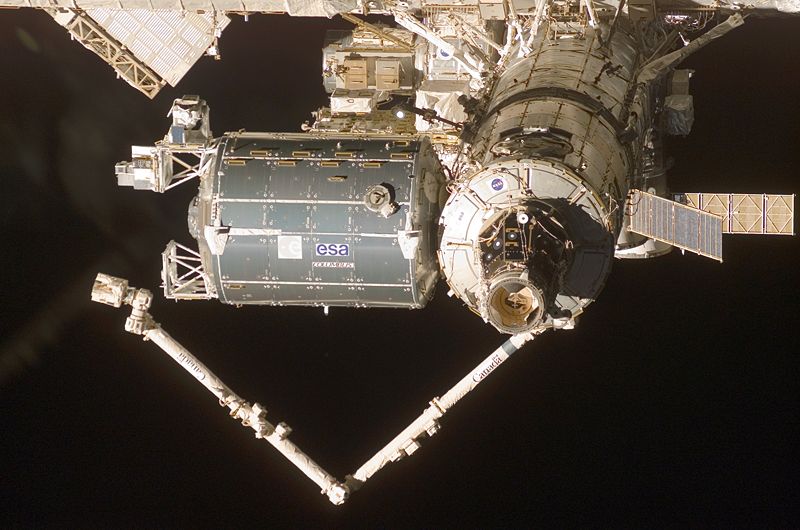
image by NASA (source)
Columbus is a lab module, packed with instruments and experiments. Here's a handy diagram showing the layout:
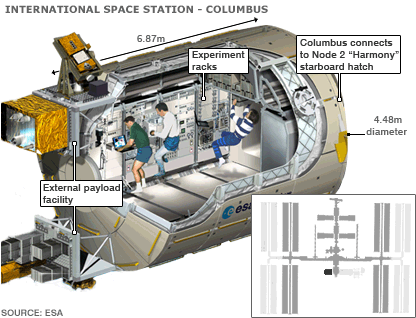
image by ESA (source)
and a nice view taken by a spacewalking astronaut in May of this year, with the Space Shuttle Endeavour there, docked to Harmony; Columbus is on the right:
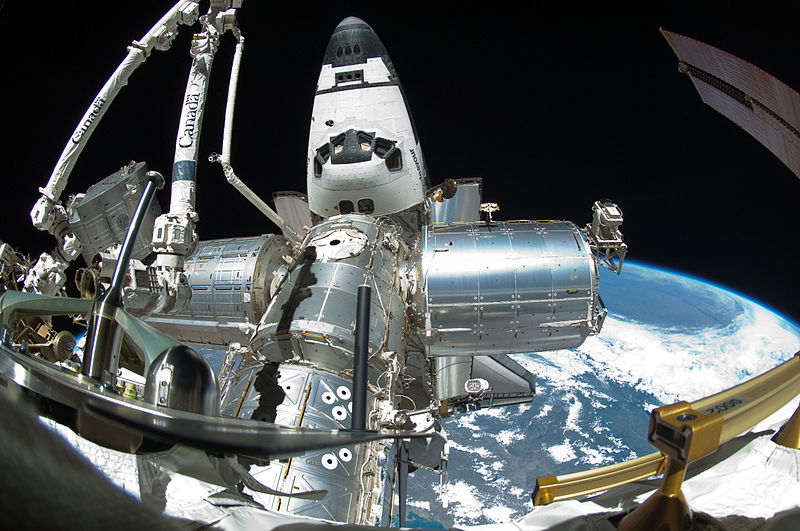
image by NASA (source)
Shiny!
Module madness continues tomorrow!
|
·····
|
| |
| The South Atlantic Anomaly and scrubbing RAM | Aug 18, 2011 3:47 AM PDT | url |
| | |
Added 1 new A* page:Yesterday I was talking about the PAMELA satellite finding 1000 times the galactic average amount of antimatter in the Van Allen radiation belt (I should have specified, in the *inner* Van Allen belt). PAMELA was able to measure the radiation in the belt from its orbit around Earth because of a peculiarity caused by the way the Earth's magnetic pole is offset from its rotational axis: the magnetic pole is tilted 11 degrees, and shifted (although I couldn't get Wikipedia to tell me why) about 500 kilometers (300 miles) to the north. The combination of this tilt and shift in the axis of the Earth's magnetic field means that the inner Van Allen belt, which forms sort of a torus centered on the Earth's magnetic axis, comes closer to the Earth's surface at an area--whose location varies over time--in the southern hemisphere. This area is called the South Atlantic Anomaly.
Here's a visualization of the Anomaly at an altitude of about 560 km, as seen in X-rays by the German ROSAT satellite in the '90's ("ROSAT" is short for "Röntgensatellit"; "in German X-rays are called Röntgenstrahlen, in honour of Wilhelm Röntgen," who discovered them--and, incidentally, in English articles soon after their discovery they were called "Röntgen rays"; hm and in a bit of current news, an analysis in February of this year found that ROSAT, containing a lot of heat-resistant ceramics and glass, probably won't burn up entirely in re-entry--so chunks up to 400 kg could come crashing violently to Earth when ROSAT re-enters the atmosphere between October and December of this year :o):

image by NASA / Steve Snowden (source)
PAMELA took its measurements for antimatter while its orbit was taking it through the South Atlantic Anomaly. The Anomaly moves and varies in size over time; it drifts to the west at a speed of about 0.3 degrees per year, which may be related to "the rotation differential between the Earth's core and its surface, estimated to be between 0.3 and 0.5 degrees per year" (that would be the Earth's solid, *inner* metal core, which is surrounded by a layer of molten metal, allowing the center to turn independently of the rest of the Earth; it's the convection of the liquid metals in the outer core, though, that is thought to create Earth's magnetic field, which, in case you're wondering, or even if you weren't, is about 50 times stronger at the Earth's core). The Earth's magnetic field fluctuates over time, though, and it is currently weakening, which is thought to be responsible for an observed gradual widening of the Anomaly: "Predictions estimate that by 2240 the SAA may cover approximately half of the southern hemisphere."
PAMELA was made to survive the intense cosmic radiation of the inner Van Allen belt, but a lot of spacecraft just have to avoid the Anomaly altogether, or switch off while passing through it. The International Space Station has extra shielding to allow it to pass through safely, and the Hubble Space Telescope doesn't take observations while passing through.
NASA has a pretty thorough article about the Space Shuttle's five general purpose computers (GPCs), including a section comparing their performance under space radiation--including passing through the Anomaly--compared with more contemporary laptop computers:
Although the GPCs run the spacecraft during a mission, astronauts take a number of relatively modern computers with them into orbit in the form of laptops. Crews carry modified IBM ThinkPad A31p computers into space with them and use them for rendezvous assistance, entry and landing simulations and e-mailing Earth.
The laptops also are much faster than the GPCs and connect with devices not available to the GPCs. The Thinkpads use one of these connections to relay photos of the external tank falling away after launch to mission control at NASA's Johnson Space Center in Houston.
But that modernity has a trade-off: the laptops are not nearly as reliable as the GPCs due to radiation effects and use of less critical commercial off-the-shelf software, Klausman said. [...]
"For critical operations, I can't come anywhere close to that reliability with the laptops," Klausman said. "They are wonderful items, but they are susceptible to radiation particles, they are susceptible to badly written software. I could put five laptops on board and all five would suffer radiation upsets within the first day."
With a ThinkPad 760XD laptop, two to three memory changes due to radiation occur during a shuttle flight to the Station, Klausman said. That number balloons up to 30 for a mission to NASA's Hubble Space Telescope. The reason is that Hubble orbits about 150 miles higher than the station, where the radiation protection from Earth's magnetic field is not as strong.
Designers also found out that laptops would crash when the shuttle passes through the "South Atlantic Anomaly," which is an area where the magnetic field draws in to Earth, again offering less radiation filtering for spacecraft flying through it.
The GPCs don't crash for radiation concerns because the GPC hardware includes a memory scrubber that prevents the system from reading radiation-changed memory. |
That "scrubber" sounds kind of neat. According to Wikipedia's radiation hardening page, "a 'scrubber' circuit must continuously sweep the RAM; reading out the data, checking the parity for data errors, then writing back any corrections to the RAM."
|
·····
|
| |
| Thorium cars and Van Allen antimatter | Aug 17, 2011 6:38 AM PDT | url |
| | |
Added 1 new A* page:Today I happened to stumble across this Yahoo! news blog post about how a Connecticut-based company, Laser Power Systems, is working on a zero-emissions car powered by thorium, a naturally occuring soft metal, named after the Norse god Thor by Swedish chemist Jöns Jakob Berzelius, who discovered the element in 1815. Thorium is mildly radioactive--the alpha radiation is emits cannot penetrate human skin--and has some useful properties that have led it to being used in things such as gas mantles--the little white baggy things that glow in lanterns--and as "an antireflection material in multilayered optical coatings." On the other hand, it is potentially dangerous in powder (spontaneous combustion in air) or aerosol (increased risk of cancer if inhaled due to alpha radiation damage to internal organs) forms.
Another property of thorium, apparently, is that it produces "heat surges" when heated by a laser, and Laser Power Systems says that eight grams of thorium, laser-heated correctly, with the resulting heat-surges being used to generate steam to power a turbine, could power a car for its entire lifetime.
There are, of course, some technical issues with this scheme, including getting dedicated thorium mining underway. Thorium is three times more abundant than uranium, being found in most rocks and soils, and a number of countries have been considering how to use it as a fuel source in nuclear reactors; there are a number of advantages it could have in that capacity over uranium, aside from its greater abundance; for instance, it's harder to get weapon-grade material from it to turn into nasty nuclear weapons, its radioactive waste decays much more quickly, it doesn't require an expensive enrichment process, and it doesn't sustain a nuclear chain reaction by itself, so a meltdown would be much less likely.
India, which "has about 25% of the world's thorium reserves," has already used thorium in one nuclear reactor, and is preparing a line of thorium-based reactors, the prototype of which is scheduled to go online this year.
~~~~~~~~
And speaking of exotic fuels, this ScienceNOW article says that scientists working with the joint Italian, German, Russian, and Swedish PAMELA satellite (that's "Payload for Antimatter Matter Exploration and Light-nuclei Astrophysics") have announced that they've confirmed the existence of antimatter in the Van Allen radiation belt encircling the Earth; since 1978 or so (when researchers came up with the theoretical CRAND ("Cosmic Ray Albedo Neutron Decay") process to describe how this could happen, I think) antimatter has been theorized to form there when high-energy cosmic rays smash into the upper atmosphere; eventually this interaction yields antiprotons, which are then trapped there by the Earth's magnetic field.
PAMELA spent 850 days sampling for antimatter in the belt regions, and succeeded in collecting 28 antiprotons; that doesn't sound like much, but it's apparently 1000 times the estimated galactic norm--"thereby constituting the most abundant antiproton source near the Earth" concluded the scientists in their research paper.
That ScienceNOW article goes on some flights of fancy about how this antimatter source could be harnessed for space flight--antimatter of course being in theory the ideal fuel, with its 100% efficient matter-to-energy conversion rate--but needless to say the amount of antimatter estimated to be in the belt, even if it could be collected and stored somehow for ship fuel, wouldn't amount to all that much; then again, it's still very difficult to manufacture antimatter on Earth, so even that tiny amount might be useful...if someone some day works out a feasible way to store the stuff for more than a split second.
(Thanks to Calamities of Nature, 'cause that webcomic's recent blog entry is where I found the ScienceNOW link.)
|
·····
|
| |
| Running robots: what are they really after? | Aug 16, 2011 2:36 AM PDT | url |
| | |
Added 1 new A* page:I found some more interesting walking robot projects by Boston Dynamics, the company developing the four-legged BigDog robot for DARPA that I talked about last time. First, there's the tiny version, LittleDog, also for DARPA, and used apparently for educational purposes at universities:
video on Youtube
Still creepy, but now kind of cute-sized. And then there's the bipedal PETMAN--not being made for DARPA this time, but due to be delivered to the US Army's Product Director for Test Equipment, Strategy and Support ("PD-TESS") this year:
video on Youtube
Pff big deal, I can run faster than that. >_>
Hm come to that when they do get one that runs faster than humans, that's when I'll really be worried (and that probably isn't too far off now, I suppose).
Over the weekend I drew a drawing not related to my comics, which you can check out on my deviantART.
But also over the weekend I did a drawing that *was* related to my comics, in fact it was my Sunday fairy tale comic, "The Princess and the Giant." And because I neglected to try to get you to go look at that series last week, I'm going to pester you twice about it this week (the next time on Friday, if I manage to stay awake this time...). So here's a teaser/link banner to the Princess page from two Sundays ago:

And if you're wondering why that looks so weird (aside from my drawing style I mean), well, you'll just have to click on it and read the comic! Muwahahahaaa!
|
·····
|
| |
| DARPA, DARPA, DARPA! | Aug 13, 2011 6:34 AM PDT | url |
| | |
Added 1 new A* page:I'm not quite done with DARPA or their Falcon Project just yet! Up until its cancellation in 2009 due to budget cuts, the Blackswift HTV-3X was going to be another hypersonic vehicle in the stable, with a two-in-one turbine/ramjet engine; the turbine would power it from takeoff up to about Mach 3, at which point the air speed would be fast enough to be pumping and compressing sufficient air into the ramjet for it to fire, pushing the craft to about Mach 6. Well, the Blackswift didn't end up getting off the ground, but you can see a simulated version of what it might have looked like, thanks to the magic of YouTube:
video on Youtube
Speaking of YouTube, DARPA has its own YouTube channel, in which they've showcased some pretty funky projects. For instance, there's the somewhat misleadingly titled "Nano Air Vehicle"--or "NAV"--project that set out to develop a remote-controlled craft capable of being launched from the hand and hovering; they eventually ended up with a pretty successful prototype that was basically a robotic hummingbird which, with its embedded camera, was capable of flying right into remote buildings and looking around inside:
video on Youtube
Not too far away from the espionage man's dream of the ol' "fly on the wall," is it?
Oh yeah, and there's the rather famous and creepy robotic pack dog they're funding:
video on Youtube
And finally, there's...PowerSwim?
video on Youtube
Oh that wacky DARPA!
|
·····
|
| |
| DARPA's hypersonic HTV-2 ditches | Aug 12, 2011 5:50 AM PDT | url |
| | |
Added 1 new A* page:Thanks to a couple A* readers of yesterday's article for tipping me off on Facebook to the results of the second test flight of DARPA's Falcon HTV-2, their hypersonic suborbital aircraft that tried to hit Mach 20 in a test over the Pacific yesterday. Apparently the launch of the HTV-2 aboard a rocket from Vandenberg Air Force Base in California went okay, and probably looked a good deal like last year's, which this YouTube video--not uploaded there by DARPA, mind you--purports to show:
video on Youtube
And I found the DARPA test flight profile footage I linked to in high-res form on their web site yesterday, in a nice streaming YouTube video on their official channel:
video on Youtube
That was how it was *supposed* to go, and they confirmed by camera mounted on the rocket, apparently, that separation of the craft took place, and their data says it shifted into its Mach 20 configuration, but then...they lost it, and it probably plunged into the ocean. This was after nine minutes of data recording, which probably not coincidentally is how long last year's test flight lasted before ending prematurely, too. Says Air Force Maj. Chris Schulz of the test: "We do not yet know how to achieve the desired control during the aerodynamic phase of flight."
But DARPA Director Regina Dugan says "We’ll try again." So, assuming their budget doesn't get cut or something, maybe we'll get these little Internet peeks at another Mach 20 test flight next year.
|
·····
|
| |
| The Falcon HTV-2 goes for Mach 20-ish | Aug 11, 2011 6:21 AM PDT | url |
| | |
Added 1 new A* page:I noticed an article today saying that the US military organization DARPA ("Defense Advanced Research Projects Agency"--not exactly the best title or acronym this nation has devised :p), after scrubbing a flight Wednesday due to bad weather, will be trying again on Thursday to launch the second test flight of the Falcon Hypersonic Technology Vehicle 2, or "HTV-2" for short. "Hypersonic" tends to mean faster than Mach 5 (Mach 1 being the speed of sound, 768 mph (1,236 kph)), and the HTV-2 is actually supposed to reach the rather ridiculous speed of "Mach 20 (approximately 13,000 miles per hour)" (which at normal temperature and pressure would be Mach 17, actually, so I wonder if they're taking a higher altitude into consideration, where the speed of sound would be less due to lower temperature, etc...or if they just like round numbers :p); the reason given for having a vehicle capable of that speed is to be able to get anywhere on Earth in under an hour--pretty mind-boggling to think about.
The Falcon definitely isn't a normal-looking craft, and it doesn't fly in any sort of ordinary way. First, it's launched in the nose of a rocket, which takes it to just below Earth orbit altitude before releasing it, as depicted in this simulated rendering from DARPA:
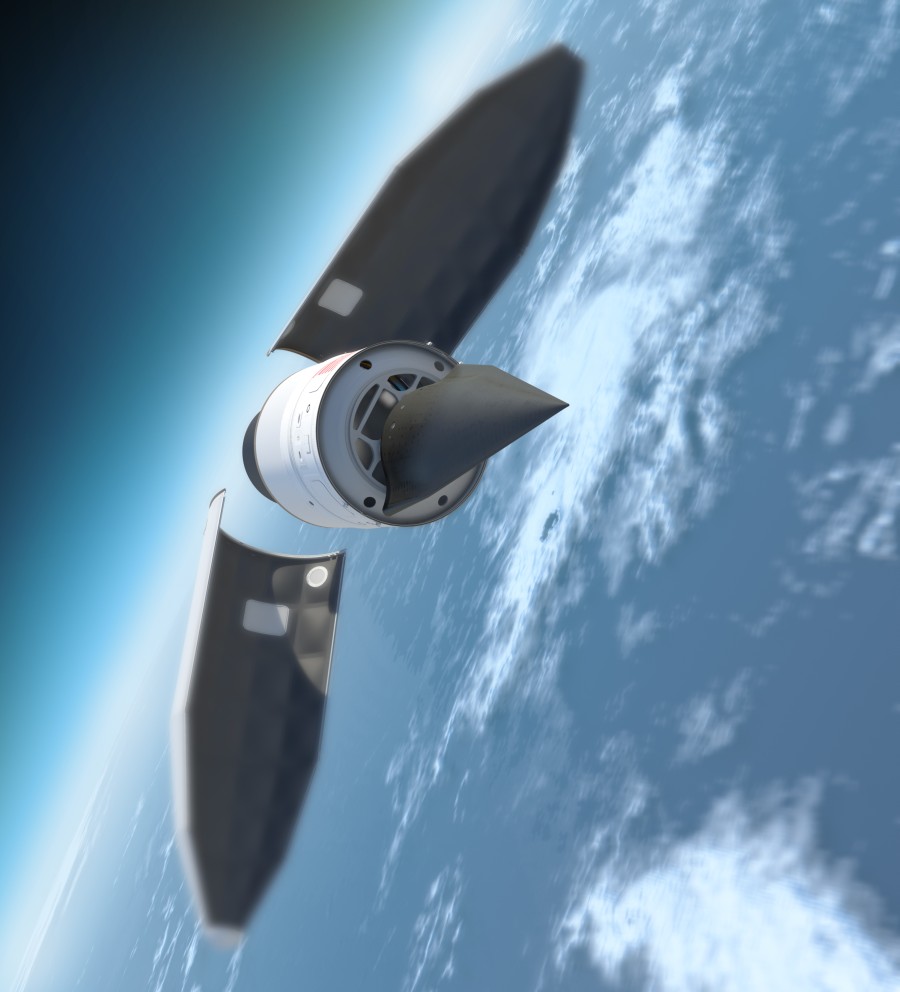
image by DARPA (source)
Once on its own, the Falcon re-enters the atmosphere, diving toward its destination:
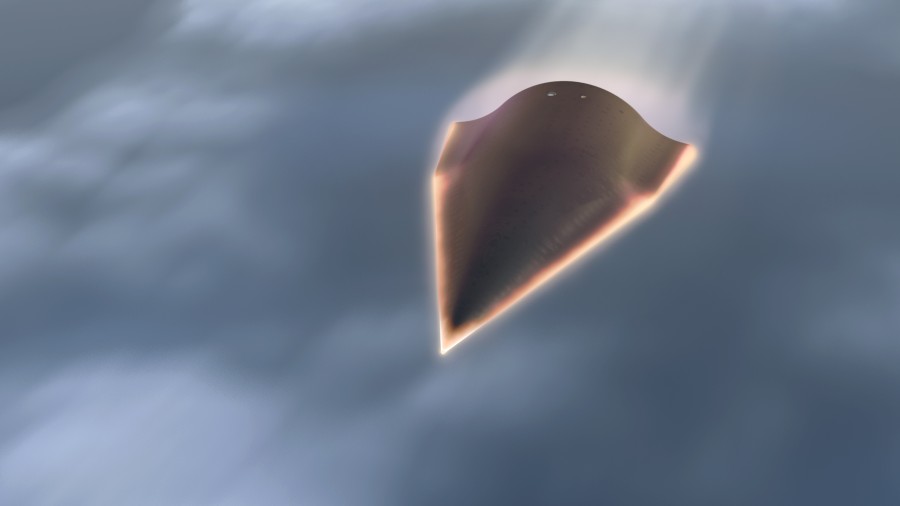
image by DARPA (source)
Its first test flight, in April of last year, did not go well: contact with the craft was lost after nine minutes, and it ditched into the ocean. These flights are supposed to go along a route something like this, I think (this chart is from last year):
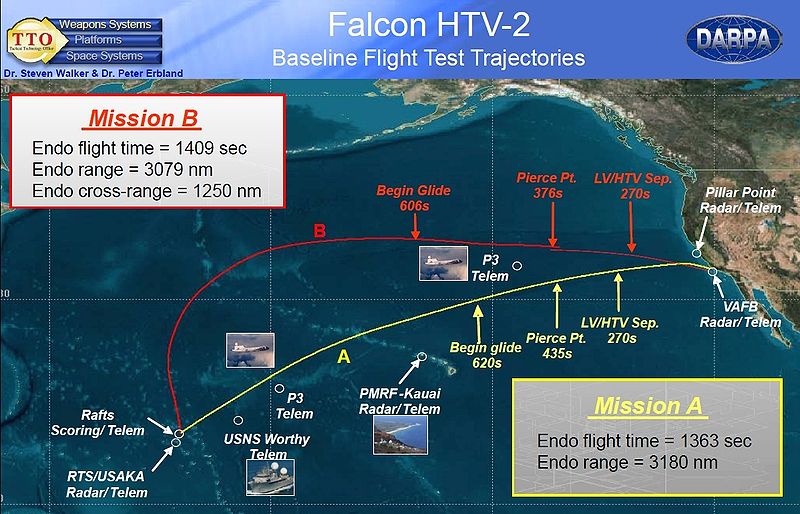
image by DARPA (source)
This second test flight, for instance, is supposed to last for about half an hour, ending with the Falcon splashing down in the Pacific, 6,400 km away from its launch site at Vandenberg Air Force Base in California. You can check out an updated overview, complete with rather high-resolution computer generated videos of each stage of the flight (in non-streaming wmv format), here on DARPA's site. One thing I found interesting about the videos was that they show how the Falcon's maneuvering jets are configured: they fire sort of crosswise across the back of the craft.
|
·····
|
| |
| Spacelab! | Aug 10, 2011 1:57 AM PDT | url |
| | |
Added 1 new A* page:I talked a week or so ago about Skylab, the space station of the 70's. Skylab, which got its name in a NASA contest, is not to be confused with Spacelab, the laboratory module, or rather series of modules, that Space Shuttles carried into orbit in their cargo bay on 22 missions between 1981 and 2000.
Many of the those trips just had "pallet" modules--platforms carrying instruments for experimentation, exposed to vacuum--but in 16 of them, the Shuttle bay played host to one of two European-built* pressurized "LM" (which I think stands for "Long Module"?) components, in which astronauts could conduct experiments without having to wear bulky space suits. This January 1, 1981 NASA concept drawing shows a Spacelab configuration with a habitable Long Module in the middle of the cargo bay, connected to the Shuttle's cockpit by a pressurized tunnel, with a pallet of equipment on its far side (five pallets could fit on a single flight, if no room was needed for a Long Module and tunnel):

image by NASA (source)
Here's a view aft into the orbiting Space Shuttle Columbia's cargo bay in 1992, with a Spacelab tunnel and LM visible:
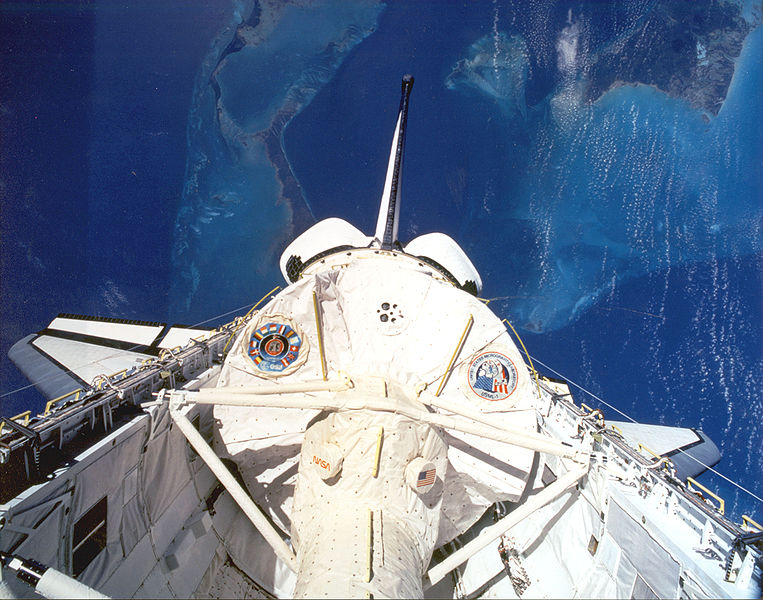
image by NASA (source)
And here's a view into the interior of the second LM built, "LM2," on display in Bremen in 2008:
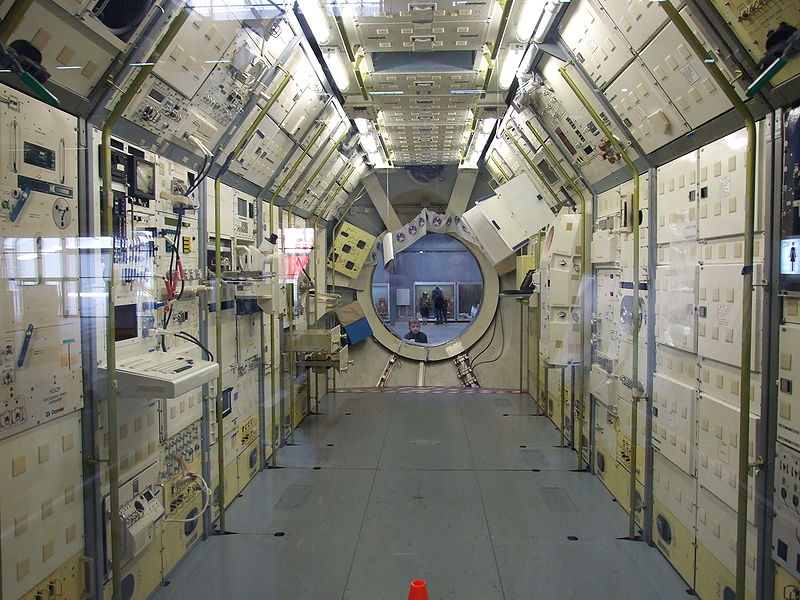
image by Kozuch (source)
At first I almost thought that was a Commodore 64 plugged in on the left side there. >_>
* Spacelab components were built by the ESA ("European Space Agency"), or even its predecessor, the ESRO ("European Space Research Organization"; in 1975, the ESRO merged with the ELDO ("European Launcher Development Organisation") to form the ESA.
|
·····
|
| |
| The 787, Opportunity's Endeavour, & space DNA | Aug 09, 2011 12:07 AM PDT | url |
| | |
Added 1 new A* page:A friend linked me to this pretty cool photo of the Space Shuttle Atlantis lit up on the launch pad and reflected in a puddle on the tarmac. It's hosted by Boeing, who still have some major facilities around my home city of Seattle, and in fact I noticed in an article earlier today that one of them just hosted the unveiling of the first 787 Dreamliner, the company's big new passenger aircraft; the first one is going to All Nippon Airways, a Japanese airline.
~~~~~~~~
I also noticed a new AP article about the Mars Opportunity rover nearing the large crater Endeavour (hey there's another Space Shuttle connection, at least in name); Endeavour is "a 14-mile-wide depression near the Martian equator," and should hold older layers of Martian soil and rock than Opportunity has found in the three previous craters it has explored, which were much smaller. Opportunity should reach the edge of the crater tomorrow; that will be the end of a seven-mile drive that has taken the rover two years! Now that's dedication; and keep in mind that Opportunity and its twin rover, Spirit--which got stuck in soft soil two years ago, but continued to transmit until last year when contact was lost--were originally planned to be just a three-month mission. And although Opportunity is expected to make the Endeavour crater its final stop, mission team members are optimistic that the rover will be able to conduct several years of exploration within its vast confines.
Here's a nifty photo Opportunity took recently--I like the look of this vast expanse of rippled Martian sand:
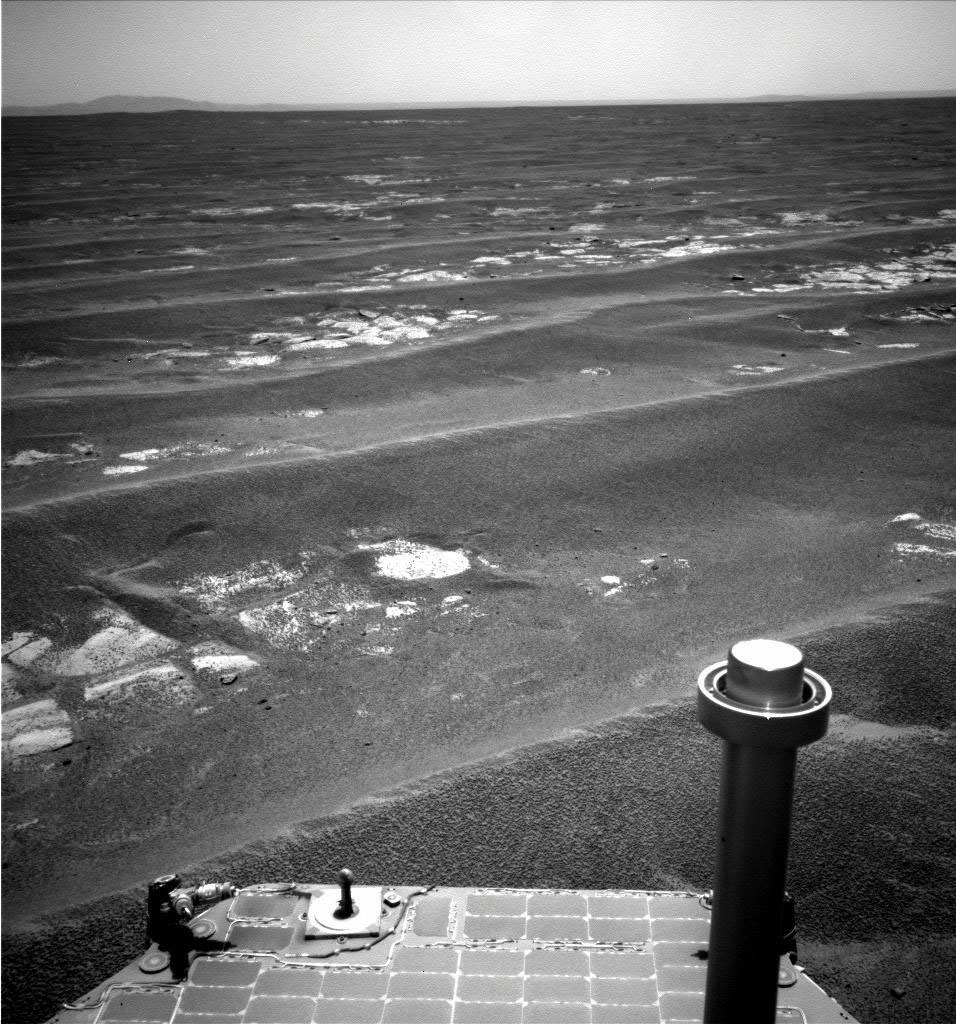
image by NASA (source)
~~~~~~~~~
And as if that wasn't enough to absorb in one day, a NASA-funded study just concluded that meteorites likely carried some of the building blocks needed for DNA to the Earth: after looking at meteorite and soil and ice samples from Australia and Antarctica, the study found that three nucleobases--which are building blocks of DNA and RNA, and thus all life as we know it--were present in the meteorites, but not in the terrestrial material around them; indeed, these particular nucleobases "are rare or absent in terrestrial biology." So the theory is that if *those* nucleobases could come here in meteorites, the ones inside plants and dogs and cats and humans and so forth could have come from space as well.
This NASA article has more about it; for instance: "The discovery adds to a growing body of evidence that the chemistry inside asteroids and comets is capable of making building blocks of essential biological molecules. For example, previously, these scientists at the Goddard Astrobiology Analytical Laboratory have found amino acids in samples of comet Wild 2 from NASA’s Stardust mission, and in various carbon-rich meteorites."
Interesting!
|
·····
|
| |
| First LEGO woman and men launch for Jupiter | Aug 06, 2011 2:08 AM PDT | url |
| | |
Added 1 new A* page:Keep an eye out for a new page of my weekend fairy tale comic, "The Princess and the Giant," this coming Sunday; here's a preview of / link to last week's page:

~~~~~~
With all the talk I've been doing of solar activity and flares and so forth in recent weeks, wouldn't you know it that the effects of some strong recent flares are arriving on Earth starting today, where they "could affect some communications for a day or so." So watch out! But these aren't particularly powerful ones; the article quotes the director of the NOAA's Space Weather Prediction Center in Boulder, Colorado as saying that the current solar storm "on a scale of 1 to 5 ... is probably a 2 or 3." For comparison, the article mentions--though not by name--the "Solar Superstorm" of 1859, the strongest solar storm on record, which even managed to burn down a telegraph office or two; I talked a bit about that 1859 event recently, right here.
~~~~~~~~
I mentioned earlier in the week that NASA's Juno spacecraft would be launching for Jupiter today (Friday the 5th), and indeed it went up right on cue on its wasp-waisted Atlas V rocket:
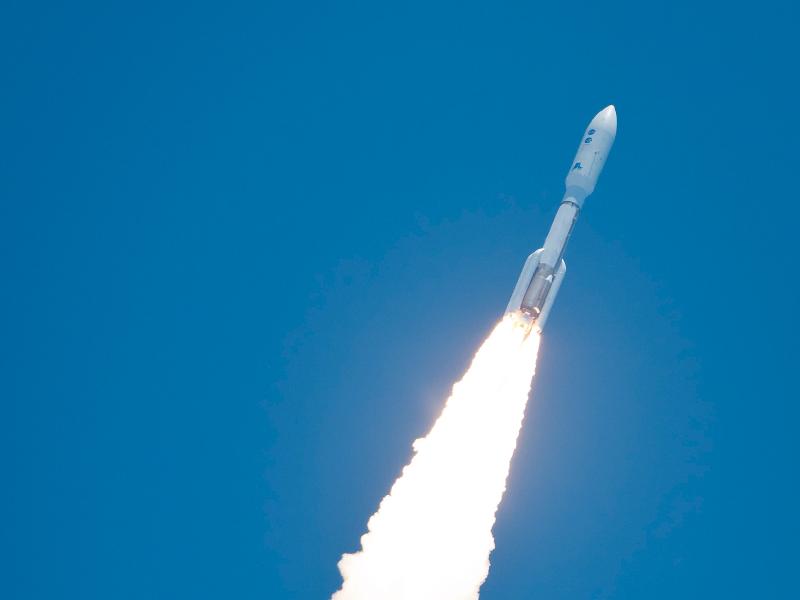
image by NASA/Bill Ingalls (source--#5 in that gallery, since I can't link to it directly)
With advances in solar panel technology, they were able to make Juno solar powered, even for operation around Jupiter, which at about 800 million kilometers out is five times as far from the Sun as Earth is, and the sunlight reaching it--or the solar panels of a spacecraft orbiting it--proportionately weaker. All the previous spacecraft to visit Jupiter--"Pioneer 10, Pioneer 11, the Voyager program, Cassini–Huygens, and the Galileo orbiter"--obtained their power from the decay of radioactive elements, in what is called a radioisotope thermoelectric generator. But scientific progress has allowed Juno to "go green," so it will be all solar rather than nuclear.
That AFP article I linked about the launch mentioned a few interesting details that I thought I'd highlight. It points out that Jupiter "has more than twice the mass of all planets in the solar system combined and is believed to be the first planet that took shape around the Sun." Also, Juno is due to reach Jupiter in 2016, and it was launched at a pretty high speed, but some creative maneuvering will help get it up to a higher speed for catching Jupiter; due--I guess?--to how the orbits of the planets work out, it will first go to the Sun, then will come *back to Earth* in a couple years before heading out toward Jupiter: "Juno will spend the first two years of its mission going around the Sun, then will return for a flyby of Earth which will give a gravitational boost to accelerate Juno on a three-year path toward Jupiter."
So see you in a couple years, Juno!
And rather amusingly--and commercially, I suppose, although the reason given is "to inspire children to explore science, technology, engineering and mathematics" (if they gave these out for free at schools that might work better!)--Juno has three tiny passengers on-board: custom LEGO-like figures sculpted in the forms of Galileo (discoverer of four of the planet's moons), the Roman god Jupiter, and Jupiter's wife, Juno; I'll let you sort out which is which in this photo, or you could cheat by reading NASA's article about them:
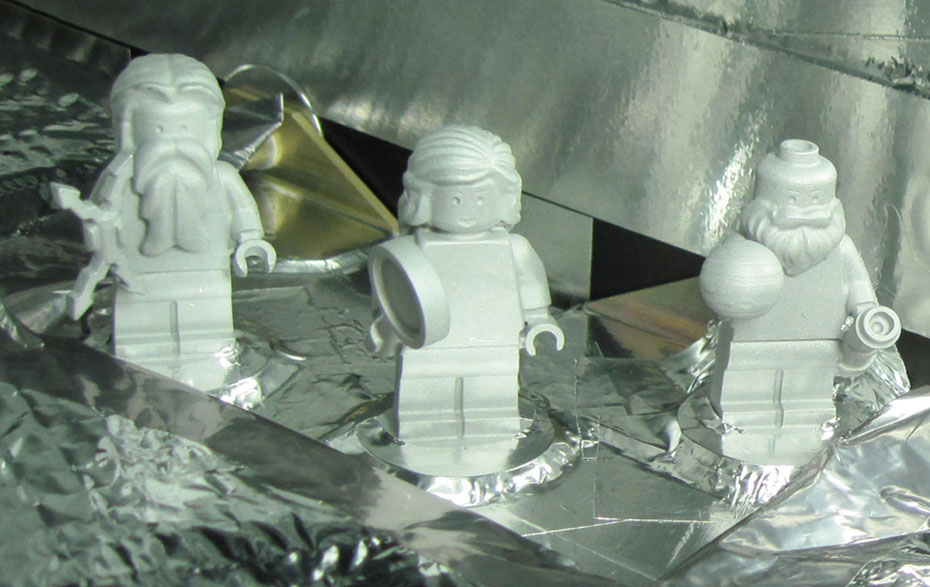
image by NASA (source)
(That's supposed to be a magnifying glass the middle one is holding, by the way! Kind of a big one... At first glance I thought it was a frying pan, and was all like "Oh NO they di-in't!")
|
·····
|
| |
| I declare today Lenticular Galaxy Day | Aug 05, 2011 1:58 AM PDT | url |
| | |
Added 1 new A* page:The galaxy I was talking about yesterday, NGC 3115, in which hot gas has for the first time been observed falling into a black hole (and a 2-billion-solar-mass supermassive one, at that), is a lenticular galaxy; lenticular galaxies are disc-shaped like spiral galaxies such as our own Milky Way, but don't have clearly defined spiral arms; they also tend to be brighter and to have larger central bulges than spiral galaxies. Since they don't have the spiral star formation areas of a spiral galaxy, they have less ongoing star formation, and tend to consist of older, redder stars. There have been theories that lenticular galaxies are old spiral galaxies whose arms--the primary star-forming regions--have used up all their gas in star formation; however, the greater brightness and larger central bulge of lenticulars suggest that there is more to their formation than just fading from a spiral. Another theory is that they're the result of a galactic collision or merger that sucked the gas away from the original spiral arms, but the bulge and the types of stars they contain don't make them an easy fit for that model, either.
I've mentioned a lenticular galaxy before, which also happens to be the largest known galaxy in the universe: IC 1101 weighs in at about 100 trillion solar masses--our spiral Milky Way galaxy, by comparison, has 0.25 trillion. So those lenticulars must be doing something right. I've got a couple pictures of IC 1101 in the post I made about it in February.
IC 1101 may be a bit bland-looking for all its size, but don't let that make you think that all lenticular galaxies are dull. For instance, the lack of spiral arms makes the bands of dust in NGC 2787 (a barred lenticular galaxy about 24 million light years away) stand out in rather impressive fashion, as captured by Hubble in 1999:

image by NASA (source)
Further afield at 500 million light years distant, but even more spectacular, is the Cartwheel Galaxy:

image by NASA/ESA (source)
The Cartwheel pretty definitely *is* the result of a galactic collision--probably with one of the two smaller galaxies to its left, or a third candidate galaxy not in the frame, which would have passed through the center of the larger galaxy. The collision produced two waves of intense star formation, now visible as an inner orange ring and outer blue ring; the outer ring is about 1.5 times the size of the Milky Way. But for some real fireworks, lets look at it in a composite of different wavelengths:

image by NASA/JPL-Caltech/P. N. Appleton (SSC/Caltech) (source)
^ That's blue for ultraviolet (from NASA's 2003 Galaxy Evolution Explorer satellite, or "GALEX"), green for visible light (from Hubble), red for infrared (from Spitzer), and purple for X-ray (from Chandra). For our purposes, the pink areas around the outside of the Cartwheel are the most interesting: those are areas of both high ultraviolet and X-ray emission, likely being generated by material being sucked off binary companion stars by stellar black holes. The blue ultraviolet of the outer wheel as a whole suggests that that intense star-forming region is creating large stars, 5-20 times the mass of the Sun. The orange center is visible and infrared emissions from the second wave of star formation; the green areas are older, less massive stars, whose primary emission is in the visible spectrum.
|
·····
|
| |
| First view of hot gas falling into black hole | Aug 04, 2011 2:07 AM PDT | url |
| | |
Added 1 new A* page:Black hole news! Data from the Chandra X-ray telescope has been used to come up with the first evidence for hot gas falling into a black hole. The galaxy in which this was observed was NGC 3115, a relatively nearby galaxy at 32 million light years from Earth. This composite image of the galaxy shows blue Chandra X-ray data over a visible light image obtained by the ESO's Very Large Telescope:

image by NASA/ESO (source)
The X-ray emissions come from binary stars, and hot interstellar gas; researchers observed that the temperature of the interstellar gas, which they can calculate based on the amount of X-ray energy it emits, begins a marked increase within about 700 light years of the galaxy's center; they think this heating can only be due to the gas being compressed as it is pulled inward by the supermassive black hole at the center. That 700 light year distance is thus NGC 3115's Bondi radius, named after the "Anglo-Austrian mathematician and cosmologist" Hermann Bondi.
A Bondi radius of that size confirms that NGC 3115's central supermassive black hole must contain about 2 billion solar masses, which I think was the approximate value first assigned to it when the hole was discovered back in 1992. That makes it the nearest billion-solar-mass-class black hole to Earth; the supermassive black hole A*, at the center of our own galaxy, boasts only about 4 million solar masses--1/500th the size of NGC 3115's! (Remember though that we already know of larger ones: M87's has been measured at about 6.6 billion solar masses, and the one at the center of OJ 287 *might* be about 18 billion solar masses.)
From the sound of his Wikipedia article, Bondi was a pretty interesting fellow. An Austrian, his prowess in mathematics took him to Cambridge in 1937, at the tender age of 18, allowing him to escape the persecution of Jews in his native country--but then, once World War II broke out, he was interned on the Isle of Man and in Canada--due to his Austrian nationality, I guess. But he went on to become a lecturer in mathematics at Cambridge, and a British subject.
And for a time, Bondi contended with the Big Bang: before the discovery of cosmic background radiation in 1964 thrust the Big Bang theory, which predicted such radiation, to the forefront, the Steady State theory developed in 1948 by Bondi, Fred Hoyle, and Thomas Gold held some sway as the scientific explanation of the universe. Einstein's general relativity had shown in 1916 that a static universe was impossible, and Edwin Hubble had shown in 1929 that the universe was expanding; the Steady State theory tried to reconcile these observations with a belief in an eternal, essentially unchanging universe--a belief Einstein had shared before Hubble's breakthrough--by positing that matter is continually created as the universe expands, keeping the average density of matter in the universe steady over time. This sounds goofy to us now, but it was tantalizingly difficult to disprove for a while, since, as Wikipedia says, "the amount required is low and not directly detectable: roughly one solar mass of baryons per cubic megaparsec per year or roughly one hydrogen atom per cubic meter per billion years, with roughly five times as much dark matter." Needless to say, the Steady State theory has long been discredited; fortunately for black hole fans, Bondi would go on to much more scientifically grounded theories. :)
|
·····
|
| |
| Taking Vesta for a spin | Aug 03, 2011 1:18 AM PDT | url |
| | |
Added 1 new A* page:I noticed in an AP article that the Dawn probe now orbiting the giant asteroid Vesta in the Solar System's asteroid belt has sent back more detailed photos. NASA says that Dawn will begin close (1,700 mile distant) orbits of the asteroid for scientific study on the 11th of this month; it will approach as close as 110 miles in its year-long study of the possible dwarf planet.
Based on the images so far, scientists have been surprised by the variety of features on the asteroid's surface, most notably a series of deep grooves along the equator, and a series of three old craters informally called "Snowman" due to their arrangement; you can see them on the left here, with some other grooves visible above them--this is from about 3,200 miles (5,200 kilometers) away (keep in mind that Vesta averages about 530 km--330 miles--across):
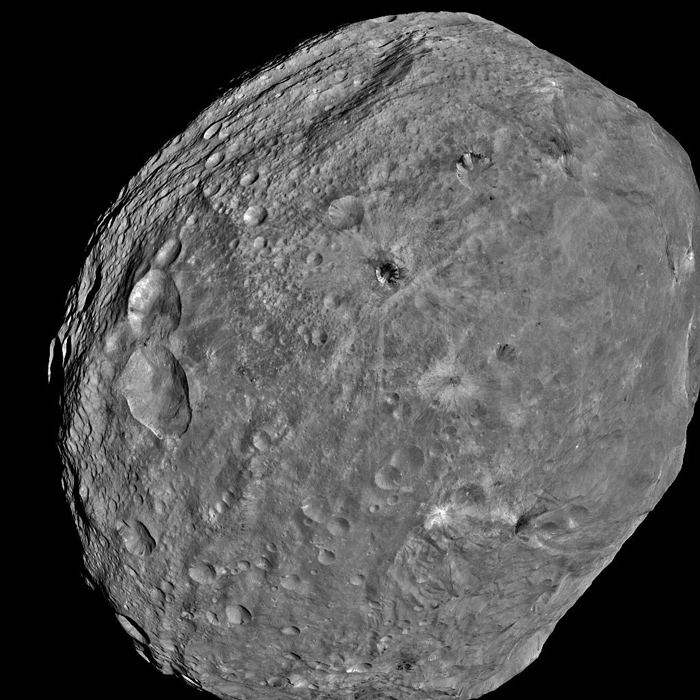
image by NASA (source)
and as seen from Vesta's dark side:
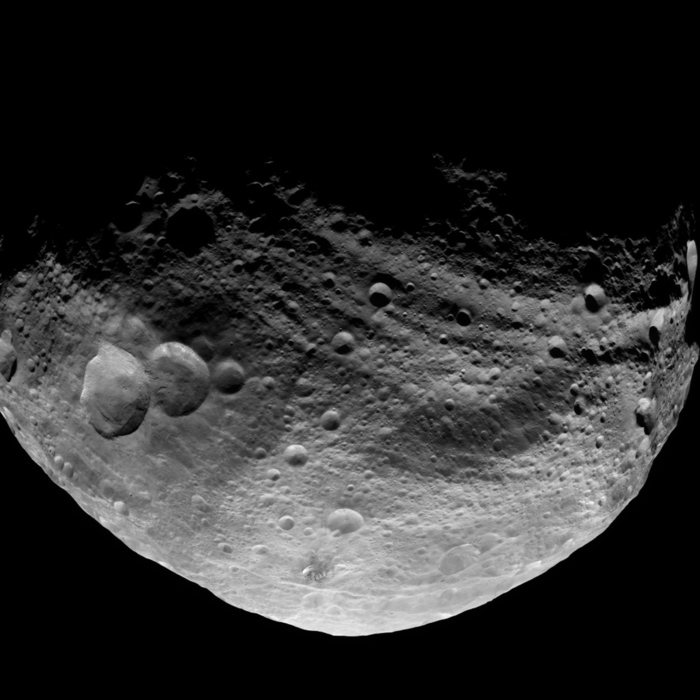
image by NASA (source)
~~~~~~
In other Solar System exploration news, the Juno spacecraft will launch on Friday for Jupiter. When it reaches the gas giant in 2016, it will conduct a detailed study of the planet's magnetosphere, among other things; Jupiter's magnetosphere should be a good one to study, because unlike a rocky planet like Earth, where a good deal of the magnetosphere is hidden from view inside the planet, with a gas giant like Jupiter the right instruments can see through the gas to study the magnetosphere right down to the center, or thereabouts (it should also be able to tell for sure if Jupiter *has* a rocky center)--also, Jupiter's magnetosphere is over twenty times stronger than Earth's. One question that it is hoped Juno will answer is whether Jupiter's magnetosphere is generated by compressed hydrogen gas inside the planet, where the pressure is so intense that it squeezes electrons off the hydrogen molecules, allowing the gas to conduct electricity, or by hydrogen even farther down, near the core, where the pressure becomes so strong that it compresses the gas down to a liquid called metallic hydrogen. Here's a NASA chart showing the types of hydrogen, along with other elements, in the gas giants:
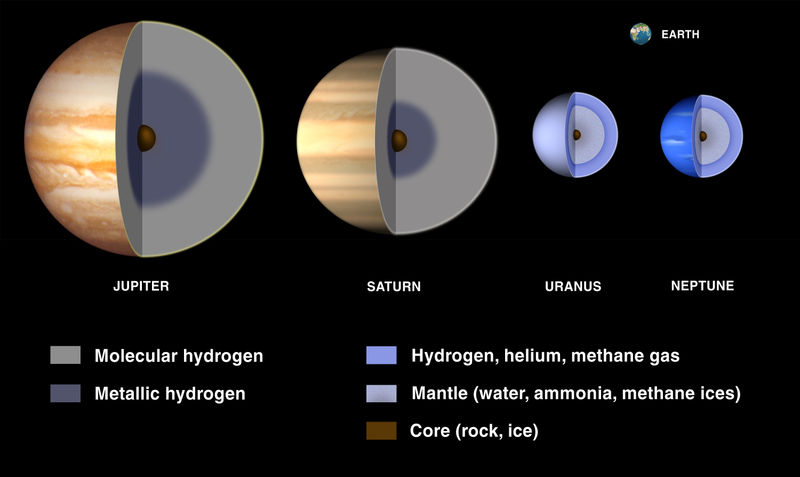
image by NASA (source)
~~~~~~
As you know, in my spare time I while away the hours googling my own stuff, and in the process of doing that this past weekend I found some nice people who've linked to A* in recent months, so now I'm going to thank them. :D A* was on someone's poll for Webcomic of the Year :o, so thanks to whoever that was--how exciting! Thanks to Mark Linimon for including A* on his favorite comics list. And thanks to Samuel John Klein and his ZehnKatzen Times site for the very interesting article analyzing the dramatic power of black and white in the context of A* and The Twilight Zone. :)
|
·····
|
| |
| The trouble with moons (and Pluto's new P4) | Aug 02, 2011 3:19 AM PDT | url |
| | |
Added 1 new A* page:The author of the webcomic Calamities of Nature has been doing a weekly science blog update, and as he seems actually to keep up regularly with goings on, I have a recent post of his to thank for pointing out that Hubble discovered a fourth moon of Pluto--or scientists using Hubble did, anyway. Currently known by clunky temporary designations--S/2011 P 1, or "P4"--it is a tiny moon with an estimated diameter of "8 to 21 miles (13 to 34 km)," which is a fair deal smaller than Pluto's two other small moons, Nix and Hydra (20 miles (32 km) and 70 miles (113 km) across, respectively), and way smaller than Pluto's largest moon, Charon, which is 648 miles (1,043 km) across (and not really all that much smaller than Pluto itself, which has a diameter of about 2,300 kilometers; in fact, Pluto/Charon qualifies as a binary system, since their mutual center of gravity is above the surface of Pluto--some astronomers, apparently, even call the pair a "double dwarf planet"; another interesting Pluto/Charon factoid is that they're both tidally locked to each other--the same part of the surface of each is always facing the other).
Here are a couple of Hubble's recent shots of the system, in which P4 could be seen:
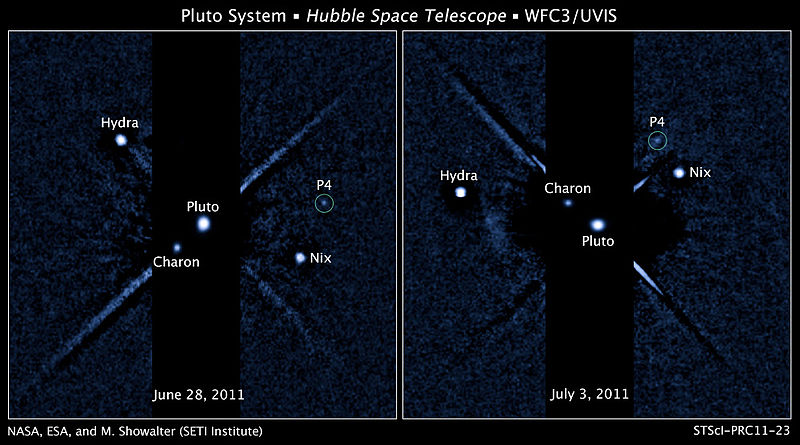
image by NASA (source)
Hubble was actually being used to look for any rings that might exist around Pluto, and the long exposures it was taking for that allowed the tiny P4 to be visible in the resulting images.
Well! It isn't every day a new moon is discovered in our solar system; and this discovery adds a bit more spice to the New Horizons mission, which is expected to reach Pluto in 2015. Will even more moons be discovered?
Surprisingly, there is no real precise definition of what qualifies as a moon. Wikipedia says: "Every body with an identified orbit, some as small as a kilometer across, has been identified as a moon, though objects a tenth that size within Saturn's rings, which have not been directly observed, have been called moonlets." So currently the title "moon" is a bit arbitrary; I would hope, though, that if New Horizons finds, say, meter-sized rocks going around in the Pluto dwarf system, they don't call those "moons"; I mean, you've got to draw the line *somewhere*, right? The line has tended to shift around, though; Wikipedia also says
| As of July 2009, 336 bodies are formally classified as moons. They include 168 orbiting six of the eight planets, seven orbiting three of the three dwarf planets, 104 asteroid moons, and 58 satellites of Trans-Neptunian objects, some of which will likely turn out to be dwarf planets. Some 150 additional small bodies were observed within rings of Saturn, but they were not tracked long enough to establish orbits. Planets around other stars are likely to have natural satellites as well, although none have yet been observed. |
That's a lot of moons already, and with better observation of who knows how many scads of Trans-Neptunian and so on objects there are floating around way out in the far reaches of our solar system, well, some day we may really be up to our ears in moons if something isn't done!
|
·····
|
|
|
